Repowering a Boat: What You Should Know
Does your boat engine need to be replaced? If so, you should review the pros, cons, costs, and considerations for repowering a boat. Stay tuned to discover everything you need to know!

What Does Repowering a Boat Entail?
So, what does repowering a boat mean? This term refers to replacing your old boat engine with a newer alternative. Doing so makes your vessel faster, more efficient, and less likely to break down.
Pros of Repowering a Boat
As mentioned, repowering your boat helps it run faster and more efficiently. In addition, here are some of the benefits:
1. Improve Performance
Replacing your old engine with a new one is a phenomenal way to maximize your boat’s overall performance. Generally, repowering a boat improves the power-to-weight ratio (making your boat easier to handle), maximizes speed and power, and offers a more enjoyable boating experience overall.
2. Extend the Boat’s Lifespan
A properly-maintained boat engine lasts many years – extending your time on the water. And not only do newer engines feature advanced technology and higher-quality parts, but they allow for longer service intervals. That means they require less maintenance.
Read Next: Boat Maintenance Guide
3. Increase Resale Value
Thinking about selling your boat? (Either sooner or later?) Because the value of your boat increases when you replace your old engine with a newer, more powerful one. Generally, buyers are more interested in purchasing modern, efficient, and dependable vessels.
4. Improve Fuel Economy
We probably don’t need to remind you that gas prices are increasing. However, newer engines allow you to spend less money on gas or fuel .
5. Better for the Environment
When repowering your boat, you can upgrade to an engine that uses less fuel and meets the current carbon pollution rules. Manufacturers make the newest machines to be as green as possible . And by reducing pollution, your boat becomes safer for the environment and the seas.
Read Next: Responsible Boating Guide
Cons of Boat Repowering
Naturally, there are two sides to every coin. Here are some drawbacks of repowering:
1. Boat Downtime Needed
Depending on the vessel’s size and the work’s complexity, the repowering process takes some time (several days or weeks.) Because you can’t operate your boat during that time, you must plan your schedule accordingly.
2. Compatibility
Believe it or not, certain engines aren’t compatible with certain types of boats. Therefore, you must verify that your fuel and exhaust systems, buttons, gauges, and electrical links work with the new engine. And note that the price might increase depending on any necessary changes.
3. Installation
Usually, you’ll need to hire professional marine technicians to handle a project of this size. They can verify that everything was done correctly and that the installation is successful. However, their expertise comes with a price, and hiring experts bumps the overall cost.
4. Repowering Costs
So, how much does it cost to repower a boat? Typically, upgrading your boat’s power source costs several thousand dollars. However, your exact price depends on factors like boat size, engine type, installation fees, boat modifications, and additional equipment.
Our advice? Do your research and collect quotes from multiple sources. That way, you can thoroughly assess your options and select the one that works best for you.
What to Consider:
Decided that it’s time to repower your boat? Before you do, there are a few considerations to keep in mind:
- Maintenance : There’s no getting around it – new engines require ongoing maintenance! When factoring this into your decision, consider the proximity of repair shops, what the warranty includes, and how easy it is to reach customer service.
- R egulations and emissions standards: Every boater must adhere to the local regulations and emissions standards. To avoid legal problems, your new engine must comply with laws regarding engine pollution, noise levels, and environmental concerns.
- Compatibility: It’s important to remember that certain engine types aren’t compatible with certain boat models. And just because someone suggests an engine model doesn’t mean it will automatically work for you.
The Bottom Line
The benefits far outweigh the cost of repowering your boat. And if you’ve decided to upgrade your boat’s power system, we hope this guide answers your questions.
On the Discover Boating Blog, you'll find boating advice, maintenance guides, and buying tips for both seasoned pros and first-time boaters. If you’re interested in learning how to care for your new boat engine, how to choose the right marine fuel and oil, or about the life expectancy of your boat engine , head to the Articles & Inspiration section of our website.
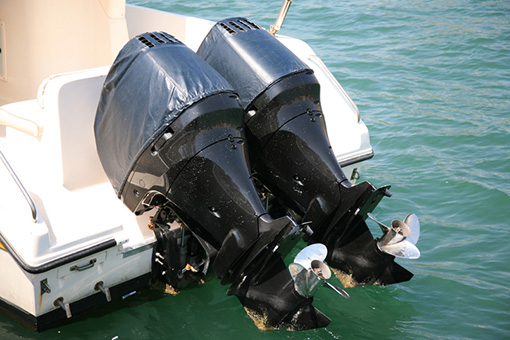
Join Our Newsletter!
Get community news, buying bargains, and how-to guides at your fingertips.
- BOAT OF THE YEAR
- Newsletters
- Sailboat Reviews
- Boating Safety
- Sailing Totem
- Charter Resources
- Destinations
- Galley Recipes
- Living Aboard
- Sails and Rigging
- Maintenance
- Best Marine Electronics & Technology

Sailboat Engine Replacement Options
- By Ed Sherman
- Updated: June 16, 2020
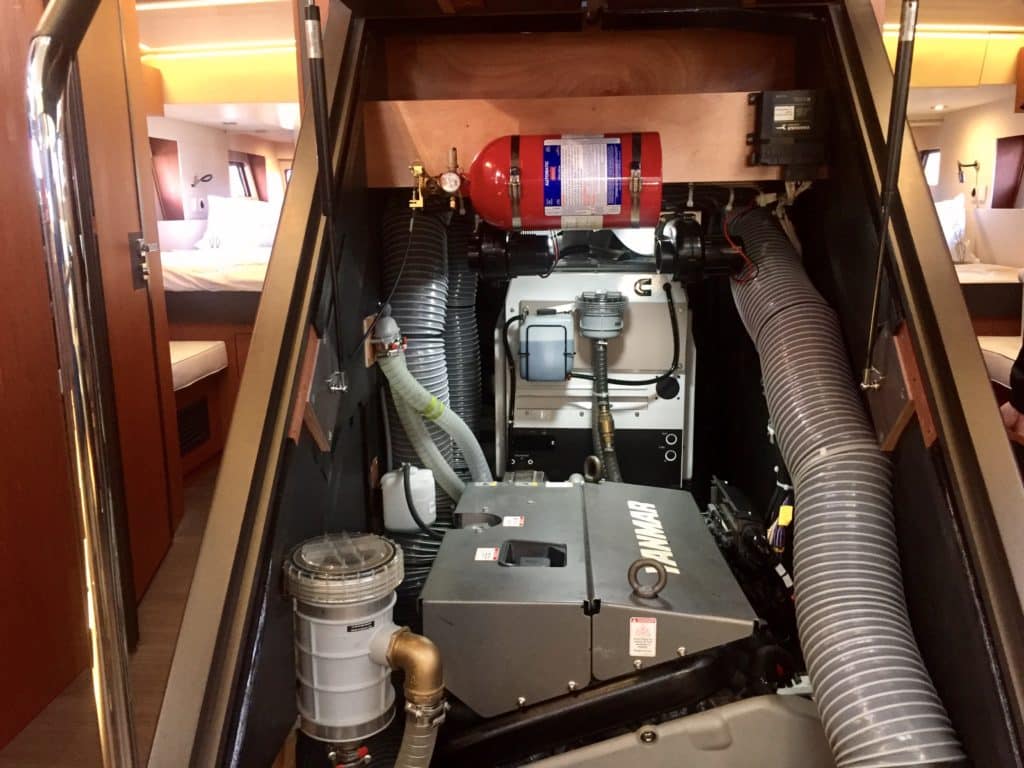
It’s the end of another sailing season, and as you haul the boat and begin its winter layup, you have reminders aplenty that the 30-year-old auxiliary engine is getting tired. The intermittent no-start condition, oil and coolant leaks, and excessive smelly exhaust smoke are finally getting to you. As you prepare to change the oil and run some antifreeze through the block, it occurs to you that it might be time for an upgrade. What should you consider? What are your choices? What are the pitfalls? Follow along and we’ll set you straight.
First off, if your sailboat’s auxiliary engine is truly approaching its third decade (or older), you need to understand that there may be significant components besides the engine that are probably going to need replacement. Things like the exhaust system, primary engine wiring harness, instrumentation, engine- and transmission-control cables, fuel tanks, transmission, shaft, cutlass bearing and prop are all suspect and need to be carefully evaluated. When looking at your options, be sure to factor all these additional items into your budget projection. Your new engine is just a part of the big picture.
Need More Power?
Back in the 1970s and ’80s, a lot of new sailboats were produced with engines that, frankly, were a bit underpowered. I know; I owned one. It was fine until I hit a head-on current in a narrow channel; I clearly remember moving along at a half-knot under full power. This scenario repeated itself all too frequently in some of the other New England waters I cruised regularly. More get-up-and-go would have been greatly appreciated.
So if you’ve experienced similar frustration, now is the time to consider more horsepower. How much is enough? You’ll need to do a bit of research to determine the best possible choice.
Consider that a sailboat is just like an airplane that stays at sea level. Power-to-weight ratios do matter: The heavier the plane’s engines, the more thrust it needs to gain altitude. The whole idea is to find the ideal balance. Simply replacing your 25- or 30-horsepower auxiliary engine with a 75-horsepower turbocharged model might sound good, but there’s more to consider than pure muscle.
First off, the 75-horsepower engine might simply be too heavy for your boat. Next, since most cruising sailboats have displacement hulls, things like waterline length and actual weight count considerably, just as they do for airplanes. With a full-displacement hull form, you can squeeze only so much speed out of that waterline length. Adding more horsepower represents a significant economic waste.
RELATED: Monthly Maintenance: Getting Back Aboard
Besides weight, physical dimensions are of paramount importance. Is it possible to get a motor-mount configuration that will work with your choice of marine diesel engine and the existing engine bed in the boat? What about service-point access? The water-pump impeller might appear to be easily replaceable on your new engine when you look at it at the boat show, but what about when it’s been bolted into place? There’s nothing worse than an engine part you simply can’t reach when you need to in a hurry. And will your engine-room space require additional modifications to fit a new muffler, filter location, shaft coupler, etc.?
Remember that marine diesel engines require a considerable amount of fresh air to run properly. Especially if you plan to increase horsepower, you may need to add engine-room ventilation to keep that new power plant from suffocating.
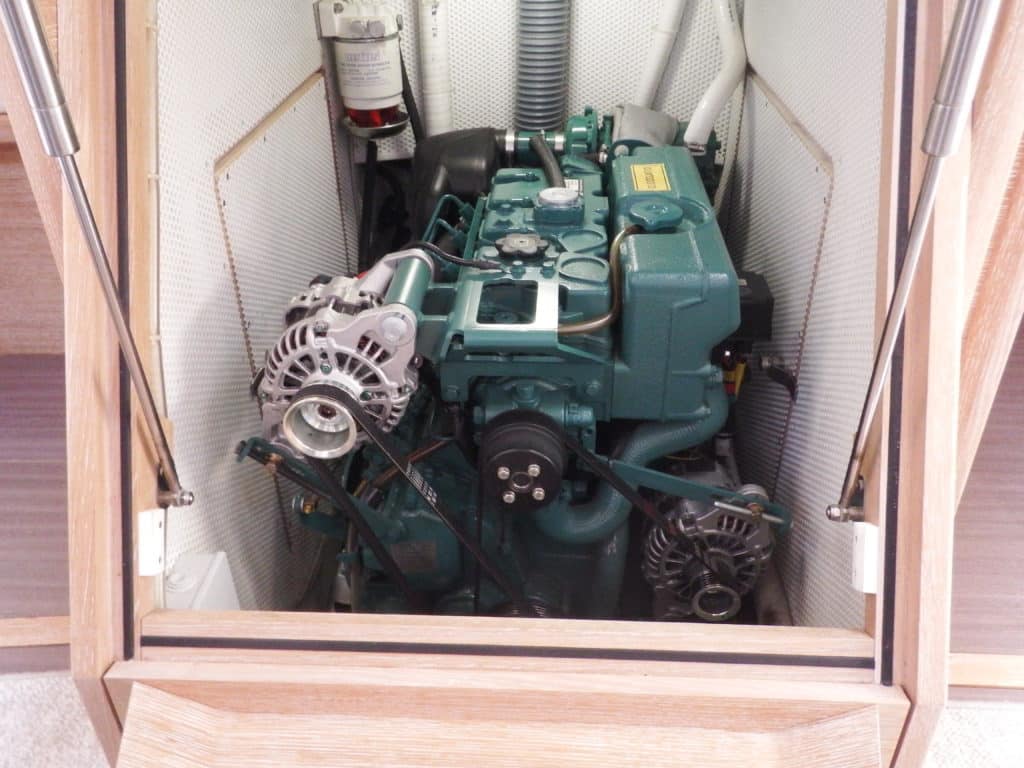
Common-Rail Marine Diesel Engines
In recent years here in the States, officials at the Environmental Protection Agency, along with their counterparts in Europe, have been working hard to create regulations that do two things: clean up diesel fuel by reducing sulfur content significantly, and eliminate emissions from the diesel combustion process.
EPA mandates now require what are described as “Tier 3” emissions standards for boats sold in the U.S., regardless of where they are made. The effect of this became evident this past fall, when I was one of the judges for Cruising World ’s Boat of the Year competition. Of the 24 boats we tested and compared, half were equipped with electronically controlled “common-rail” super-high-pressure fuel-injection systems. The new diesels use a common chamber that is often, but not always, integrated into the engine’s cylinder head, and which holds fuel for all the cylinders in the engine. The fuel is pressurized by a pump that operates at much higher pounds-per-square-inch than those used in older systems, which sent fuel from the fuel pump directly to individual fuel injectors at each cylinder.
In older marine diesel engines, fuel pressure typically ranged from a low of about 1,500 psi to close to 4,000 psi. In these systems, the injectors opened when fuel was compressed to what is referred to as the injector “pop” pressure.
In common-rail diesel engines, injectors are still used, but the pressure in the rail chamber is on the order of 15,000 psi to 20,000 psi. Injectors, meanwhile, are controlled by electronic solenoid valves, whose opening and closing time is controlled by an onboard CPU that adjusts the duration of each burst of fuel based on data inputs like temperature, engine load and rpm.
Here’s the good news: You’ll never have to bleed air out of these systems, as they are completely self-bleeding. With older marine diesels, bleeding was a fairly common task required after fuel-filter changes or running out of fuel. This problem is simply eliminated with the common rail. All that’s needed is to crank the engine, and the high-pressure pump will take care of the rest. Now here’s the bad news: The biggest fear with these engines is a problem with the onboard electronics. Rather than carrying spare fuel injectors, long-distance cruisers may now want to carry spare injectors and a spare engine-control CPU.
The hope, of course, is that the reliability of the engines will negate the need for fuel-system maintenance; routine fuel- and oil-filter changes can still be done by the owner. Problems will arise, though, when an engine doesn’t perform as it should. These are complex machines, and without the proper skills and equipment (diagnostic computers and the ability to read error codes), a boat owner probably won’t find a way to sort things out as he might have with a traditional marine diesel.
The Kiwi delivery skipper was aboard one of the boats I boarded during the boat show in Annapolis. It was a multihull, powered by a pair of common-rail diesels, and I asked the obvious question: How have these engines been, in your experience? His answer was telling. He said he was glad to have two engines on these catamarans because usually one of the two will have problems during the delivery — problems that he can’t solve. If you’re contemplating a voyage on a single-engine monohull, you would probably find that response unnerving, to say the least.
Rebuild or Replace the Auxiliary Engine?
As I stated earlier, the simple solution to your power needs may not be to replace the 25-horsepower with the beefy 75-horsepower motor. Depending on your boat and circumstances, you may still be able to get a currently compliant (EPA-wise) engine in the lower-horsepower range that still uses older technology. The dividing line at present is found at about 50 horsepower, depending on the manufacturer.
If you think you need more than that, you’re probably going to end up with an electronically controlled diesel engine with all the fixings — and a major series of modifications to your old boat will be needed to make the change.
If that’s the case, the possibility of rebuilding your existing sailboat auxiliary engine may make better economic sense, but only if the circumstances allow it. If you are merely trying to get a boat refreshed for resale within a year or so, the overhaul of your existing engine makes some sense. A rebuild typically will save several thousand dollars, compared with a full-on replacement. But you’ll only be able to enjoy a very limited warranty on the work, compared with the two- to five-year peace of mind that comes with a new marine diesel’s warranty. Further, realize that as the engine ages, parts become increasingly difficult to find; next time a repair becomes necessary, it may be impossible. If you’re planning on keeping the boat, in my view, a repower is the only intelligent solution.
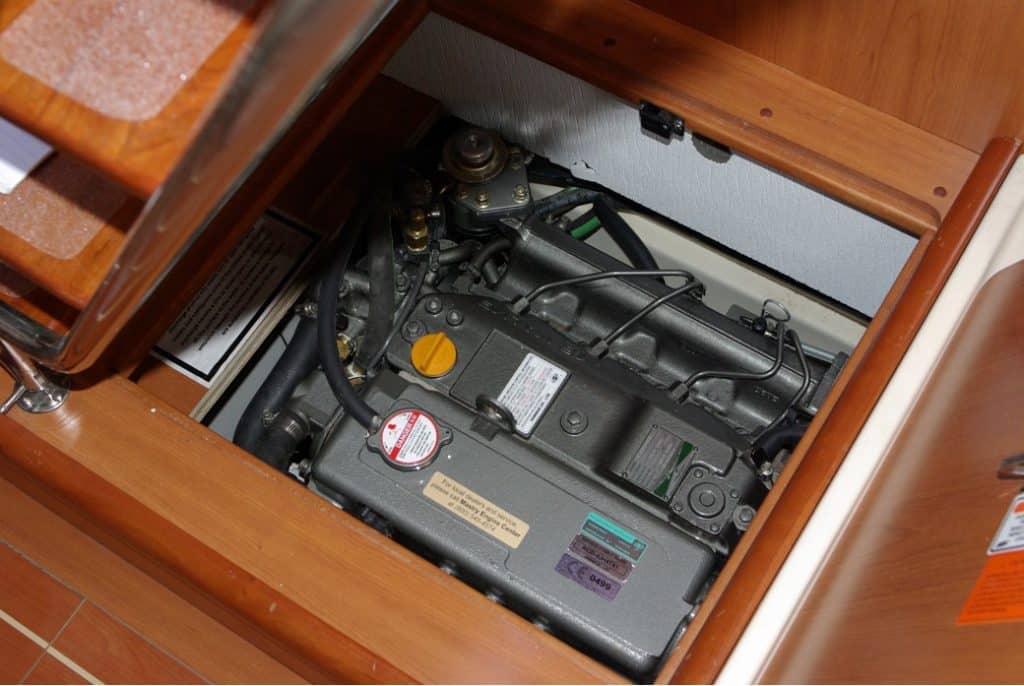
Marine Diesel Engine Comparison
A search for sailboat auxiliary diesels yields results that would indicate there are really only seven brands: Yanmar, Volvo Penta, Beta, Westerbeke, Perkins, Vetus and Nanni, with Yanmar and Volvo Penta maintaining significant market share. Of the 24 sailboats in our BOTY mix this year, 11 were powered with Yanmars and 10 with Volvo Pentas. We had one boat with twin 20-horsepower Honda outboards, one with twin Nanni diesels, and one sailboat with an electric drive. You’ll probably read in online forums that most marine diesels are made by either Kubota or Mitsubishi, but that’s not quite accurate.
Yanmar produces all of its engines, and Volvo Penta manufactures its larger ones in-house. Smaller Volvos are produced by Perkins and given a Volvo-green paint job. Understand that Perkins uses the Kubota diesel as its base engine and then marinizes it to its own specifications. Perkins, which is a subsidiary of Caterpillar, is based in the United Kingdom, but also has some distribution here in the United States.
Nanni, a French company, uses Kubota, Man, Toyota and John Deere engines as its bases, depending on the horsepower. Vetus, with very limited U.S. exposure, has used Kubota, Mitsubishi and other base engines over the years. I can remember vividly a customer of mine years ago with a Vetus that used a four-cylinder Peugeot diesel as its base.
The bottom line today is that the volume of engines produced for the marine industry is quite small by industrial standards. Globalization has made it easy for manufacturers to source base engines for marine use that might also be used in tractors, generators and other relatively small machinery in both on- and off-road applications. With that in mind, it pays to check out the dealer and distributor network from both a regional and international perspective before you make a final choice. Beta, for example, has a significant dealer and parts network here in the U.S., so if you plan on cruising locally, parts and repairs should be easy enough to find. Beta, Yanmar, Volvo Penta and Westerbeke also offer a variety of engine-mount options to accommodate the various footprints that installers may encounter.
By comparison, if you opt to go with a Nanni, here in the States at least, repairs might not be that simple. I needed no less than 30 minutes and three phone calls to the Florida distributor to find out what the U.S. warranty covers. I still don’t know. I found the Australian distributor’s website, which mentions a two-year “plus one” guarantee, but the definition of “plus one” wouldn’t upload. On sailing forums, I found quite a few folks who complained about hard-to-find and expensive parts. It seems when Nanni marinizes, say, a Kubota engine, things like air-intake filters and other common service items are proprietary, and so replacements can’t necessarily be purchased at the local Kubota tractor dealer on some remote out island. Since the company is based in Europe, service and parts may be more available there.
For those who use their boats only occasionally and close to home waters, service and parts availability may not be a big enough issue to outweigh other considerations, such as cost. But if long-distance cruising is in your plans, it pays to carefully assess service and parts availability from a global perspective.
As for your modern electronic common-rail diesel engine, if that’s the way you must go, at the very least, stick with one of the two major manufacturers, Volvo Penta or Yanmar — and even then, good luck if you get hit by lightning halfway to Tonga. You’ll be hard pressed to find a service technician in a timely fashion, so carrying spare electronic components should be a serious consideration.
And a final note: For those of you who are on the last go-round with the venerable Universal Atomic Four gasoline engine, it’s time to switch to a diesel, if for no other reason than the continued availability of parts. If you want to stick with the Universal brand, give Westerbeke a call; the company still supplies two Universal engine models — the M3-20 B and the M-25 XPB — that are bolt-in replacements for the gas units. By the way, these are both Kubota-based engines.
Ed Sherman is the vice president of the American Boat & Yacht Council and heads its education division. He is a frequent CW Boat of the Year judge.
- More: DIY Sailboat Projects , engine , engines , How To , power , Refits , systems , Upgrades
- More How To

3 Clutch Sails For Peak Performance

It’s Time to Rethink Your Ditch Kit

8 Ways to Prevent Seasickness

How To De-Winterize Your Diesel Engine

Kirsten Neuschäfer Receives CCA Blue Water Medal

2024 Regata del Sol al Sol Registration Closing Soon

US Sailing Honors Bob Johnstone

Bitter End Expands Watersports Program
- Digital Edition
- Customer Service
- Privacy Policy
- Email Newsletters
- Cruising World
- Sailing World
- Salt Water Sportsman
- Sport Fishing
- Wakeboarding

Service Locator
- Angler Endorsement
- Boat Towing Coverage
- Mechanical Breakdown
- Insurance Requirements in Mexico
- Agreed Hull Value
- Actual Cash Value
- Liability Only
- Insurance Payment Options
- Claims Information
- Towing Service Agreement
- Membership Plans
- Boat Show Tickets
- BoatUS Boats For Sale
- Membership Payment Options
- Consumer Affairs
- Boat Documentation Requirements
- Installation Instructions
- Shipping & Handling Information
- Contact Boat Lettering
- End User Agreement
- Frequently Asked Questions
- Vessel Documentation
- BoatUS Foundation
- Government Affairs
- Powercruisers
- Buying & Selling Advice
- Maintenance
- Tow Vehicles
- Make & Create
- Makeovers & Refitting
- Accessories
- Electronics
- Skills, Tips, Tools
- Spring Preparation
- Winterization
- Boaters’ Rights
- Environment & Clean Water
- Boat Safety
- Navigational Hazards
- Personal Safety
- Batteries & Onboard Power
- Motors, Engines, Propulsion
- Best Day on the Water
- Books & Movies
- Communication & Etiquette
- Contests & Sweepstakes
- Colleges & Tech Schools
- Food, Drink, Entertainment
- New To Boating
- Travel & Destinations
- Watersports
- Anchors & Anchoring
- Boat Handling
- ← Technology
Repowering Your Boat: What You Need To Know
Advertisement
There are many considerations when starting a repower project, including some that are unrelated to the performance requirements of your boat.
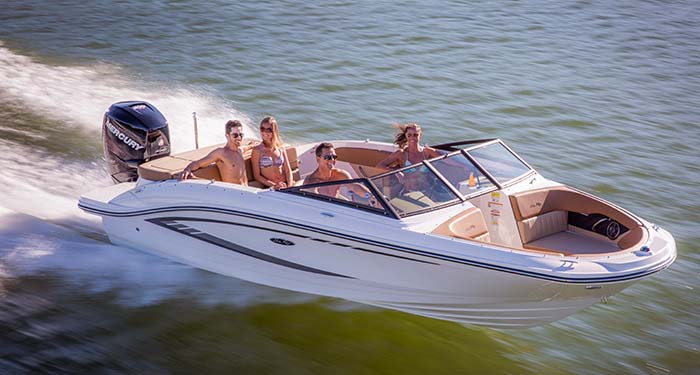
These five below, should give you a good starting point from which to plan your shopping list.
Transom Limitations: Space and Weight
The physical limitations of your transom will dictate how much horsepower and weight you can put back there. While modern four-strokes are getting close to their two-stroke counterparts in weight, they still will add to the load at the stern. If you were not running the maximum-rated horsepower in your previous set up, you may have some wiggle room, and be able to absorb some extra weight without impacting seaworthiness. It's a good idea to check with your boatbuilder what the design limitations were before you start shopping. Weight considerations could limit you to DI two-stroke technology.
Space is more of an issue if you are running twins (or more) because some of the high-horsepower modern four-strokes need more width between the engines, but not always. Honda, for example, designed their four-strokes to fit the standard footprint for easy repowers.
In addition, with the increased horsepower ratings available today, you may wish to switch from twins to a single outboard configuration. For example, swapping twin-150s for a single 300-hp motor, in theory, will reduce both weight and drag, which should increase fuel economy without sacrificing performance. However, boatbuilders caution that the increased power and torque of these modern, power-dense outboards can be too much for transoms that weren't designed for it. A safe bet is to limit horsepower to the highest horsepower single engine configuration offered as original equipment. The boatbuilder should be able to go into greater detail.
Rigging: Time To Upgrade To Electronic Controls?
This is your chance to simplify your dash and clean up the console, as well as consider adding joystick control, if you are running twins. If you've got a large multifunction display, you may also wish to network it to your outboard(s) to allow it to display engine data. To do so, you need to look for an outboard that supports NMEA standard data outputs or one that offers a "gateway" converter that changes proprietary outputs into a data stream that your chartplotter can use.
Converting to joystick control will also require hydraulic steering, and a specialized command bus to talk to the joystick.
How you intend to use your outboard? If you do a lot of trolling or low speed operation, you may benefit from an outboard that makes use of fuel saving tactics like stratified combustion. If you run offshore or through an inlet to go fishing, you may benefit from electronic throttle controls combined with an outboard with instantaneous mid-range punch.
Maintenance Schedules
Scheduled maintenance intervals have a big impact on the cost of ownership during the life of the outboard. In general, DI two-strokes will have longer intervals between scheduled services because they lack mechanically-controlled drive trains that need adjustment every 500 to 1,000 hours. Although recently Mercury unveiled a 150-hp four-stroke that should not require valve adjustments at all during it's lifetime. Four strokes also need regular oil changes. But annual oil changes should be weighed against the operating cost of burning oil in a DI two-stroke.
Electrical Demand
The amperage output of most outboards has increased over the years, but if you run an electric trolling motor all day, or a suite of electronics while drifting or slow-trolling, the alternator on your outboard better be able to keep up. Check not only the rated amperage output, but also make a note of what the output is a low rpm, where it could half of what it is a cruising speeds.
Related Articles
The truth about ceramic coatings for boats.
Our editor investigates the marketing claims of consumer-grade ceramic coatings.
Fine-Tune Your Side Scan Fishfinder
Take your side-scanning fishfinder off auto mode, and you’ll be spotting your prey from afar in no time
DIY Boat Foam Decking
Closed-cell foam flooring helps make boating more comfortable. Here’s how to install it on your vessel
Click to explore related articles
Michael Vatalaro
Contributor, BoatUS Magazine
Michael Vatalaro is the former executive editor of BoatUS Magazine. He has a Pursuit center console, which he uses in the Chesapeake Bay.
BoatUS Magazine Is A Benefit Of BoatUS Membership
Membership Benefits Include:
Subscription to the print version of BoatUS Magazine
4% back on purchases from West Marine stores or online at WestMarine.com
Discounts on fuel, transient slips, repairs and more at over 1,200 businesses
Deals on cruises, charters, car rentals, hotel stays and more…
All for only $25/year!
We use cookies to enhance your visit to our website and to improve your experience. By continuing to use our website, you’re agreeing to our cookie policy.

Download Our Repower Guide for FREE!
Repowering your boat is a major decision and there are several things to consider. We’ve collected some important information to help guide you through this decision and process. Connect with a certified YANMAR dealer or distributor when you are ready to make the next steps in your repower project.
Sign-up to receive the latest information from YMI about new products, services, and updates.
Dealer Locator
YANMAR’S extensive global service and parts network spans 130 countries and over 2100 locations.
We’re here to help and would love to hear from you. Contact us with inquiries, comments, and feedback.

Elige tu idioma
Choisissez votre langue, velg ditt språk.
Nederlandsk
Portugisisk
Välj ditt språk
Portugisiska

How Much Does It Cost To Repower A Boat?
The limitation is a factor that stays alive in most of the products available in the market. Any mechanical equipment of any kind will have certain restrictions to help stabilize the machine’s security without breaking it.
Going over the limitation in any mechanical equipment will show signs of wear and tear and other problems that will appear menial at first but soon will take up prominent space in the product. Like any other engine, the sailboat engine has its limitations, and once the engine reaches the limit, it will start showing issues all around.
An average marine gasoline engine can run for 1,500 hours, and once the engine reaches that number, it will need a bit of overhaul. On the other hand, Marine diesel engines can exceed the limits of a marine gasoline engine, and a diesel engine can go for 5000 hours without showing any sign of slowing down.
Table of Contents
How Much will repower a boat cost?
When you plan to repower a 32 to 34-foot sailboat, you can consider a cost of around $6000 to $7000. Repowering an engine might appeal to people, but there is another option, you can install a new machine. That will mean removing the old one, and here the price can move around from $2000 to $4000 .
On average, you can look forward to spending more than $5000 . If you are lucky enough to get an acceptable deal, you will find it near the $5000 figure. But the best estimate for repairing the boat sets the number at $10,000.
Should you spend money on labor charges?
The additional labor charge will be extra since the removal of the engine is not something that everyday people can do in an instant. There are caution and producers attached to removing an engine out of a sailboat , and it is better to leave this work in the hands of a professional with a few dollars. People move to the repowering engine once they know the machine they currently implemented on the boat doesn’t meet the emission regulations.
Should you repower or replace the engine?
To comply with the latest emission regulations, the owner must repower the engines to avoid charges if the engine has about 50% of the life expectancy. Once the machine has reached the 50% limit, replacing it might be the best choice.
A proper replacement can cost you around $5000 ; this can be done by taking a part of the old engine and then resembling the new machine from a short block. Cutting the time on reinstallation will save you money and time on the engine.
Cost to replace a Mercruiser engine?
The cost here can range from $12,000 to $14,000 , depending on the drive choice and the engine. You will have to take off some existing blocks to make room for the new ones. If you have done it before, you will not have any difficulty doing it. But if the work is too strenuous for you, you can think about hiring labor to install a new engine.
Should You Repower The Boat Or Look For Another Method?
Buying an updated boat is much easier and replacing the current ship is a better option, but these options come with a steep price tag. If you lack funds to repair the ship to function better, you can think about powering an outboard boat. Downsizing the engine might not seem like a good idea, but it genuinely breathes a new life to the ship, and often we see an enhanced performance.
How long can an engine last on a boat?
With proper maintenance, you can raise the expected lifespan of the engine by a lot. Adequate care can bring the lifespan of a diesel boat to 6000 to 8000 hours . Diesel engines tend to last for a long time compared to engine functions on gasoline.
Frequent use of diesel engines will affect the durability of the machine. If you keep everything under proper control, you can run the engine for a long time without going through any significant investment.
Does repowering increase the value of the boat?
Repowering a boat will not be cheap; you will have to pay a lot of money to get it done. Undertaking a huge cost will not go well with all the people. If you are planning to sell the boat, you need to know whether repowering the ship will add value to the engine? It may not add any value to your boat as you might have imagined. The price of each motor can go upwards of $25,000, depending on the size .
Only the people who see themselves running the boat might invest the cash to repower the ship; if they don’t get any value out of the boat, they might think about purchasing something new.
Some might think about using an old motor on a new boat; older controls will not work with the new engine, and even if they did, you would face several challenges in making it work. It is often better to replace the old components to add some life back to the machine rather than keeping up with the old ones.
Repowering a boat might be appealing, but it does not cost-friendly. You will spend a lot of money to get the engine repowered. But many people in this situation tend to go for the other route; rather than deal with the repower headache. Simple replacement sounds more promising to many people as it costs less and resolves the problem.
When you repower the engine, it does; ‘t add anything to the boat’s value. If you are considering repowering because you want to list the boat in the market, you should know that repowering doesn’t increase the boat’s value in any way. Make sure to find a reputable shop for installing a new engine or repowering.

At HowMuchDoesCost, you will find costs related to everything imaginable; we collect the different costs from various sources present on the internet and give you all in one information without losing time searching for deeper pieces of information. Our main goal is to provide you with a depth overview of the cost that you need to afford for a service, animals, and much more.
Disclaimers
Privacy Policy
Terms And Conditions
- MarketPlace
- Digital Archives
- Order A Copy

Repair, rebuild or repower
When you have an older boat like we do — a 1987 Moody 422 sloop — and you’re living aboard and cruising it full time, the process of repairing and replacing gear is part of life. We’ve replaced sails and electronics over the years. We bought a new dinghy and replaced the outboard. We’ve put in a new complement of batteries twice already and upgraded wiring and solar panels. We’ve replaced yards of line and pounds of hardware. But now we are facing a very tough decision — the main engine.
We consider our main engine a vital piece of safety equipment. Yes, we are a sailboat and we try to sail as often as we can, both because we enjoy it and it saves fuel costs. But there are times when running the engine is critical: when you know bad weather is approaching and you can motor your way clear; when a narrow atoll entry requires an engine that will get you through the pass safely; and simply working your way into an anchorage and setting the hook. For all of these situations, a solid engine is essential.
Our engine is a 50-hp Perkins 4-108 built in 1987. We aren’t quite certain how many hours it has because when we purchased the boat in 2004, there was no hour meter and we’re the third owners. We put an hour meter on and have added almost 3,000 engine hours since we’ve owned it. Over the last three years it seems we have been putting more and more dollars into repairs.
Now we have a few more issues looming large and we are asking ourselves the big question: “Do we continue to repair it, rebuild it, or do we bite the bullet and buy a new engine?”
Repair You do this whether it’s a new motor or a good old workhorse engine. Things break or wear out and need to be replaced. We have lots of spares for our engine aboard and Michael is capable of doing most of the repairs himself. It’s when the big issues come up that we bring in the experts — and in remote places this is often difficult (if even possible) and usually expensive.
Getting parts for an engine that is 28 years old can sometimes be an issue. We checked on a new starter and the only way to be certain it would be the right one was to send our old one in to the parts company. We were in New Zealand at the time and dealing with a U.S. supplier, so the cost of shipping back and forth would have been both very expensive and time consuming. We opted to have the starter rebuilt at almost the same cost as a new starter minus the shipping. We are still not certain the rebuild was done correctly.
We looked at all the major repairs we have done over the years as part of our analysis for this “big” question.
Before leaving, we put on a new transmission and damper plate. In the last six years of cruising we have done the following major repairs on our engine: replaced fuel lift pump; new main rear and front oil seal; rebuilt fuel injector pump; injectors serviced; new high pressure fuel lines; new motor mounts; new raw water pump; two new alternators; heat exchanger core cleaned and tested; and exhaust mixing elbow replaced twice.
When these repairs are amortized over all the miles under the keel, this has not been too extreme. One mechanic we trusted in the U.S. once told us, “A good diesel engine will corrode out before you wear it out.” And though the repairs hurt every time we clunked down a thousand of our favorite American dollars (it always seems to be at least $1,000), it is a chunk spread out over time. It may be $1,000 at a time — but that may be easier to swallow than a lump sum of many thousands to rebuild or buy a new engine. Repairing usually means only a short time out of commission to do these repairs.
Looking back over the six years of cruising, having tracked each dollar we spent, we spent around $8,000 on parts and mechanics for the main engine alone. That does not include all the spare parts that we used on it that we already had on board before departing Florida in 2009. It also does not include the consumables like oil or filters, which we would use on a new or old engine. Amortized over the six-plus years of sailing, we are probably spending about $1,500 a year on main engine repairs. Would investing in a new engine cost us less annually over the long run, and would we see those savings or will the next boat owner reap the benefits?
Peace of mind is probably the biggest concern with this “repair” option. As we write this, we are at a very remote island in the Banks Islands group of Vanuatu. There are no repair facilities or parts around — the closest is a plane ride away. The engine has a cooling water leak and a small diesel leak on the injector pump. We don’t want to mess around with the engine too much here, but we still have a long haul to get back to New Zealand and don’t want to do that passage with a dodgy engine. So we will have to invest some repair dollars in hopefully solving these problems while still in either Vanuatu or New Caledonia.
Rebuild The Perkins 4-108 is a solid engine. Parts are still relatively available, though the places to get them are becoming more limited with each passing year. Mechanics can usually be found in most locations that know this motor. So, our second option is to have a total rebuild, top to bottom, of our existing engine.
We carry lots of spares for this engine, so a rebuild would save us having to buy new spares for a newer and different engine. Michael has worked on this engine quite a bit and knows it pretty well so there would be no new learning curve for him.
The key to the rebuild will be finding someone who can do the job so we have confidence in the work. Someone we can trust. We’ve had both good and bad experiences with mechanics over our six years of cruising. Finding someone willing to take on this project who is capable of quality and timely work will be the single largest challenge in this option.
The cost of this more major “repair” is also a factor. We estimate that the cost will be around $10,000 for a major overhaul. That is not a hard number, just an estimation for our thinking process. Of course, the price will adjust after a diagnostic of the engine determines how deep we need to go. Before we make a firm decision, we need to get more accurate numbers, then add 25 percent for the “unforeseen” extras. We will also have to be out of the water and out of commission. Because the boat is our home, living aboard during a major rebuild will also be tough. There may be additional costs with finding a home away from our floating home.
A well-done rebuild should give us the peace of mind to head into even more remote locations. The key will be finding the right person to do the job while in New Zealand — there at least we won’t have a language issue complicating the process.
Repower This is the big pill to swallow. It is a big chunk of money in one fell swoop. We are on a cruising budget and that is always a hard thing to accommodate.
Though there are never any guarantees, we know that with a new motor we would feel more confident in remote locations. Plus the new motor will come with some warranties. The good news is we could also upgrade our horsepower. Currently, we feel slightly underpowered with the 50-hp engine. We probably could also save some money on fuel and oil with a more efficient power source. The updated engines are also better equipped to handle some of the newer low-sulfur and bio-diesels that seem to be more prominent — and often the only option — in various locations. We most likely will also save a few pounds of weight aboard with a more efficient newer engine.
The hardest part will be fitting a new engine on the existing engine room platform. Though engines are now smaller and more efficient than 28 years ago, the boat was constructed with the braces and mounts for our current Perkins engine. The good news about a replacement motor will be the opportunity to totally clean out the engine room, repaint it and make the most efficient use of the space.
Besides the cost of the actual new engine, there are many more costs associated with a repower. New fuel lines, hoses, wiring, shaft, an exhaust system and, of course, spares. New belts, filters and backup parts will need to be added to the spares locker. Add the cost of the haul-out, shipping, finding a place to lie our heads while the work is being done and the cost of a mechanic, and the price tag gets mighty hefty. What is a reasonable price for more power and peace of mind?
Again, our price on the engine is a rough estimate; as we get closer to making a decision, we would have a firm negotiated price tag. It’s hard to get prices in the remote islands! We spoke with one mechanic and he said to double the price of the engine to include the installation. Of course this is most likely to have the mechanic do all the work. In our case, Michael would do a lot himself and use the mechanic for his expertise. So perhaps we wouldn’t have to quite double the price.
Are we overreacting with even thinking about repowering? We repowered our last boat and felt like it was a mistake. We sold the boat within a few years of repowering. The new owners got the benefit. We got the bill.
We know this boat will be our home for as long as we decide to continue cruising. We are still enjoying the experience and plan on a few more years. After we’re done cruising, we’ll sell this boat and get something smaller. We decide annually if we’ll continue cruising and if so, where we’ll go. If we stay in the South Pacific region, making the run between New Zealand and the islands, the “repairs” options makes the most sense. If we want to venture into Indonesia and beyond, we would be more confident with at least a rebuild. Or should we just go ahead and upgrade with a newer model engine? We know we won’t get the money out of a new engine when we sell, but perhaps it will speed the sale.
Barbara Sobocinski and Michael Hawkins live aboard their Moody 422 sloop Astarte . Since leaving St. Petersburg in February 2009, they have explored the Caribbean and the Pacific.
By Ocean Navigator

Beta Marine Repower Center
Marine engines, whether or not they get a lot of use, wear down over time. They don’t run efficiently, they lose power, and they become a money drain. Replace your old, tired, outdated marine engine with a reliable Beta Marine diesel engine today. Use our resourceful Beta Marine repower center to find the right engine for your boat. There are lots of variables to consider when making a decision, such as the boat, engine bed, and how you plan to use the boat. Our consultants can help you make sense of all the variables. Choosing the correct engine to repower your sailboat depends upon several different criteria and we would always recommend that you discuss with other owners of your class of yacht as well as your local Beta Dealer or engine installer. Utilize the Beta Marine repower center to begin your search.
CONTACT A REPOWER CONSULTANT
Or call 252-249-2473
If you are human, leave this field blank. Name * Phone * Email * Confirm Email * Boat Make & Model * Current Engine * Other Comments * Captcha * reCAPTCHA is required. SEND

- Center Consoles
- Dual Consoles
- Motoryachts
- Sport Cruisers
- Tenders & Ribs
- U.S. Atlantic
- Engine Buyers Guide
- Electronics
Repowering an Old Boat

Many consumers are choosing not to wait six months to two years to take delivery of a new boat.
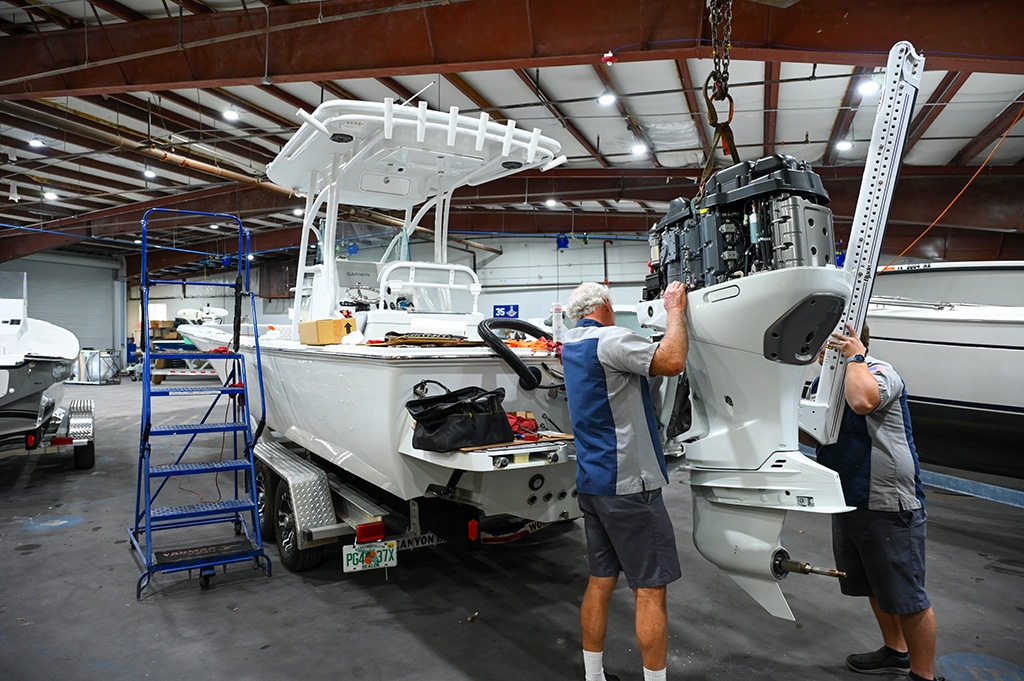
Recommended
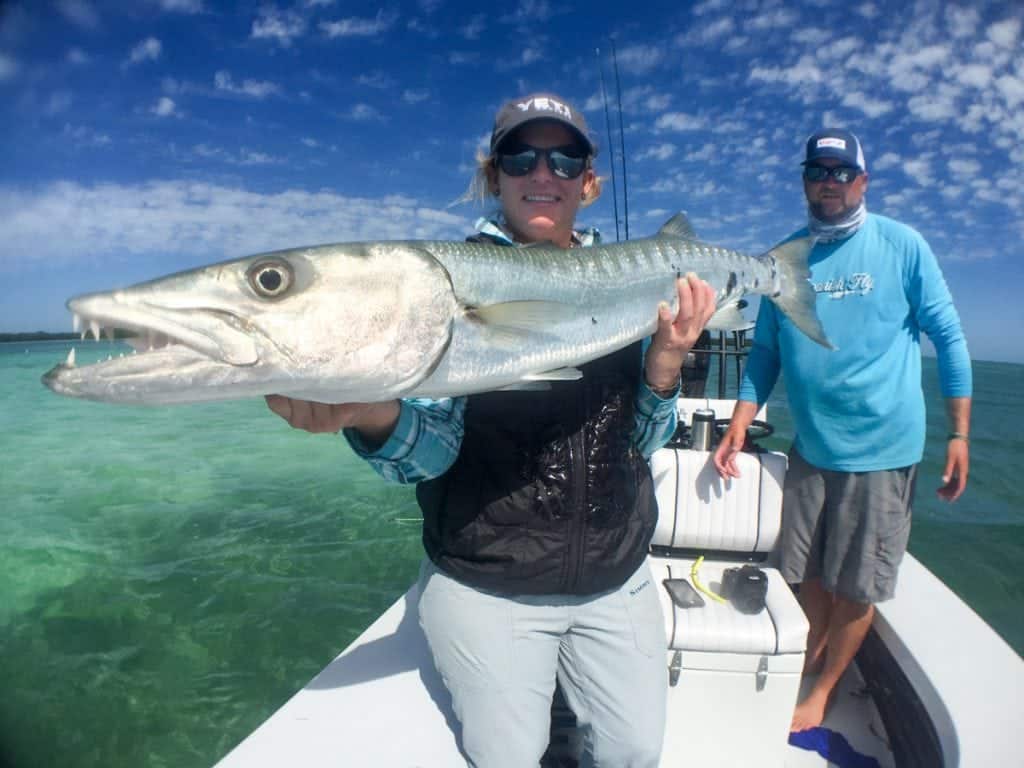
Fishing Florida in February
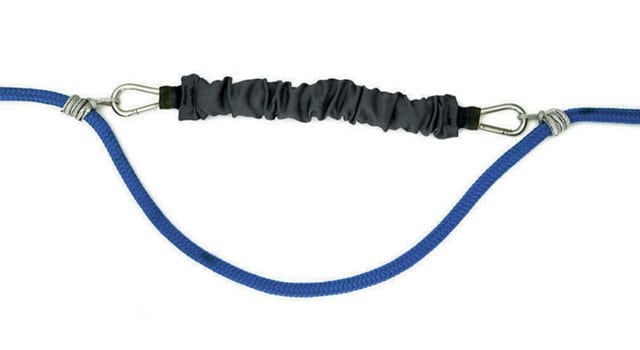
DockShockle
Don't miss it.

Ranieri International Appoints Madison Bay Holdings the Exclusive Representative Throughout The Americas

New Podcast Episode: Palm Beach International Boat Show Preview


The Race Between Semiconductors, Gold, and Cocoa Heats Up!

Discover The ULTRA Anchor: Stay Secure With Quality Stainless Steel

Sister Semiconductor Surges and Shines!

Celebrate the Water’s Elegance with Hinckley’s 30th Anniversary Picnic Boat
- Privacy Policy

1591 E. Atlantic Blvd, 2nd Floor Pompano Beach, FL 33060 Office: +1 (954) 522-5515 Fax: +1 (954) 522-2260 Contact us: [email protected]
Email address
© 2024 Southern Boating Media
Authorised Suzuki Sales, Fitment & Service Centre
News: Boating
Newly repowered: check out the new outboards we fitted to these boats.

All our real and recent boat repowers (WATCH). Plus: Repower options, the boat repower calculator, what repowering a boat means and how to calculate your engine replacement cost
15 June 2019
What does it mean to repower your boat? Well, it’s basically putting new engines on, usually with more power and smarter tech. Fitting new outboards is one of the fastest, easiest and most cost-effective ways to give your boat more speed, performance, power and lower fuel costs. And there are loads of awesome options when it comes to a boat repower.
A repower is as easy as taking a look at the available outboards and then speaking to our sales guys and technicians in our Suzuki workshop , deciding on the repower option that’s best for your boat and your budget, and then booking your slot to have the new motors fitted. They’re brand new, fully tested, fitted and certified, plus you get a new warranty on the new outboards too.
Repowering your boats is probably one of the most satisfying ways to increase power on your boat without breaking the bank. See what the owners of these recently repowered boats have to say:
NEW BOAT REPOWERS
Jubal repower: upgrade to twin suzuki df100s.
More responsive, fuel savvy and a smoother ride. WATCH here:
New Suzuki DF100s on Ace Cat 555 Super stable steering. Lightest in its class. And so much more oomph. Check out the twin DF100s we fitted to Charles Wright's 5.5m Ace Cat. Now you're gonna do a lot of lekker deeper fishing, Charles and family! We'll show you more on this project soon. #GetNautiIn the meantime, discover the Suzuki DF100 here: https://nautitechsuzuki.com/outboards/df100b/ Posted by Nauti-Tech Suzuki on Monday, 2 September 2019
“You have to love the performance on these Suzuki four strokes, they’ve just got a bit more grunt in them. We took Jubal with the new motors out for the first time last Saturday and, boy, do they run well. I had to keep playing on that edge between too much and just having fun out on the water,” says Charles Wright, owner of the recently repowered Jubal .
5.5-Metre Ace Cat | Prev: 90hp 2 strokes | Repowered: 2 x New Suzuki DF100
ZEE KOETS REPOWER: UPGRADE TO TWO SUZUKI DF80S
Better performance for less fuel, more torque and superior after-sales service that seals the deal. WATCH:
Repower: DF80s on a 5-metre powered cat Instant acceleration and a finely tuned gear ratio. Doing a PDI on two new Suzuki DF80s on a 5.7-metre powered cat that loves going after tuna. Get the full sotry on the repower here: https://nautitechsuzuki.com/zee-koets/ #GetNauti Posted by Nauti-Tech Suzuki on Thursday, 6 June 2019
“I had two Suzuki 70s on before, and of course they were great motors, but you can feel the difference with the new Suzuki DF80s . I can now run at 1000rpm and get to the same speed I’d normally have to up to higher revs for. It definitely uses less fuel now, and the power configuration is just ideal for my boat,” says Emile Coetzee, owner of newly repowered Zee Koets .

UKWABELANA REPOWER: UPGRADE TO TWO SUZUKI DF325S
More power, less fuel and greatly improved functionality on this incredibly hard-working 13-metre marine research vessel. WATCH:
The best things come in twos. Dual louvre, dual prop, dual injection and the efficiency of a 300hp packed into the power of a 325. Check out the two DF325s we fitted to a 13-metre powered cat research vessel for the South African Institute for Aquatic Biodiversity, Makhanda, Eastern Cape recently. Read all about it here: https://nautitechsuzuki.com/ukwabelana/. Plus: More on the Suzuki DF325 here: https://nautitechsuzuki.com/outboards/df325a/ #GetNauti Posted by Nauti-Tech Suzuki on Thursday, 23 May 2019
“The new outboards are just awesome, the boat’s got more life now, so much more oomph. We used to have 300hp motors on, and getting the new Suzuki DF325s , well, that’s definitely a step up. It’s like the boat’s just come to life. That dual prop and better systems just mean she has more power now,” says Koos Smith, skipper of the newly repowered uKwabelana .

13-Metre Powered Cat | Prev: 300hp outboards | Repower: 2 x New Suzuki DF325
ABOUT BOAT REPOWERS
What are my repower options.
Well, you can start by checking out the available outboards . And then it’s always good to chat with sales guys and technicians because you want to be sure that you select the right outboards for your repower. You want to take your boat’s size and max engine weight into consideration, to be sure you select the right option. And then also ensure the steering and all systems are compatible. For the best advice, contact Nauti-Tech Suzuki here .

OUTBOARD REPOWER CALCULATOR
To get a general idea of how much power you need for your boat repower, you can use your boat’s weight as a guide. Convert your boat’s weigh into pounds, so a 2.2-ton boat becomes a 5000 pound. Normally, for a fairly average performing boat, you need about one horsepower (hp) minimum for every 25–40 pounds of weight (the range is wide because of all the different types and brands of boats you get).
If you take 5000 and divide it by 200, you get 25 pounds per horsepower. And, 5000 divided by 125 is 40. So you can get away with 125hp–200hp on that boat. But the lower that number is, the better your boat will perform. Try dividing 5000 by 300 and you’ll get 16.6, which is starting to become nice and fast. Divide it by 400 and you’re building a boat you’re gonna love.

Now, if you’re fitting two engines, remember that you’ll divide that horsepower by two. So, our super 400hp becomes two 200hp outboards. And then it becomes important to keep each individual outboard’s weight in mind. The two outboards together shouldn’t weigh more than your boat manufacturer’s max spec for your boat, so you’ll have to play with different configurations until you find the one that gives you the best power-to-weight ratio and works for your pocket. Fortunately, the technicians in our workshop will help you determine your best options.
Get the inside track on how to choose an outboard for your boat .
CALCULATING BOAT ENGINE REPLACEMENT COST
With outboard motors, it’s fairly simple. Your costs are the price of the new outboard(s), plus labour, fitment and testing. Now, it’s important to take into account the systems and steering, because those need to be compatible, otherwise, they’ll need to be replaced, which can add to the costs.

WHAT’S THE BEST OUTBOARD ON THE MARKET?
Now, we’re not going to tell you Suzuki is the best. Make up your mind for yourself: Suzuki is the most awarded outboards manufacturer in the world, having won 8 National Marine Manufacturers Awards (NMMA) for Innovation since 2003, plus two more awards in the 1990s. Check out the list of Suzuki awards .
Suzuki is currently the best-selling outboard in South Africa. Perhaps because we offer great value for money, excellent after-sales service, advanced tech like Suzuki Lean Burn that boosts your boat fuel economy and performance, and every Suzuki outboard also doubles as a trolling motor .

But, when it comes to repowering your boat, it’s all about what really works for you.
NEED A BOAT REPOWER?
Check out our Suzuki outboards and enquire about boat repowers .
Did you know we also do complete boat refurbs? Check out the before and after on Line-Breaker . And y ou can also browse pre-owned boats, outboards and accessories among our used boats .
Discover 7 BoatPro reasons to start boating .
And, it’s official: See why Suzuki is the No 1 Best-Selling Outboard .

PLUS: CHECK OUT THIS NEW LAUNCH
We’ve just launched Jan Hendrik Hattingh’s new CarryCat 900, the Carry On 2 .

Plus: What happens when you fit two 140s on a 6.7-metre boat specced for max 115? Find out with recently launched brand-new boat Seadation .
Also check out Robin Vermaak’s all-new CarryCat 760 game fisher, Piromero .

Plus: See all our custom-built new boats and all our favourite new launches under our full collective post on our boats .

THE PURSUIT OF AWESOME
Legend also has it that CarryCats and every other boat runs better under Suzuki power. Discover it for yourself among these Suzuki outboards .

BUILT FOR FISHING
Legend has it that it’s more fun fishing in a CarryCat. So tell your friends who might not know yet to check out the little-big CarryCat 670 , the next-level CarryCat 740 and the all-round great fisher CarryCat 760 .

Discover more specs, options and configurations for bass boats, riverboats and ski boats under our section on new boats .
BE THE FIRST TO KNOW
To ensure you always get first dibs on the latest deals and be the first to know about new, events and special offers by joining the Nauti-Tech Suzuki Facebook community and signing up for our newsletter .
— Need to refurbish, refit and revive your boat? Take a peek inside our award-winning Suzuki Marine workshop .
READY TO #GETNAUTI?
- 2024 BOAT BUYERS GUIDE
- SHALLOW WATER FISHING
- Email Newsletters
- Boating Tips
- Boating Safety
- Electronics
- Best Marine Electronics & Technology
- Baits & Lures
- Fishing Tackle
- Fishing Travel
- Conservation
- Fishing Knots
- Women in Fishing

10 Questions to Answer Before Repowering an Outboard Boat
- By Jim Hendricks
- Updated: July 16, 2019
The thought of purchasing a new fishing boat always sounds tempting, but for many would-be buyers, the timing might not be right. If the propulsion system on your current boat is growing tired, however, the timing might be right for fresh horses.
Repowering a boat is a great way to extend the life of a fishing machine. Yet there’s more to consider than just bolting on new engines . You need to figure out how much it costs to repower your boat, and weigh a number of additional options. Here are 10 questions to ask yourself or your dealer, with answers offered by outboard experts.
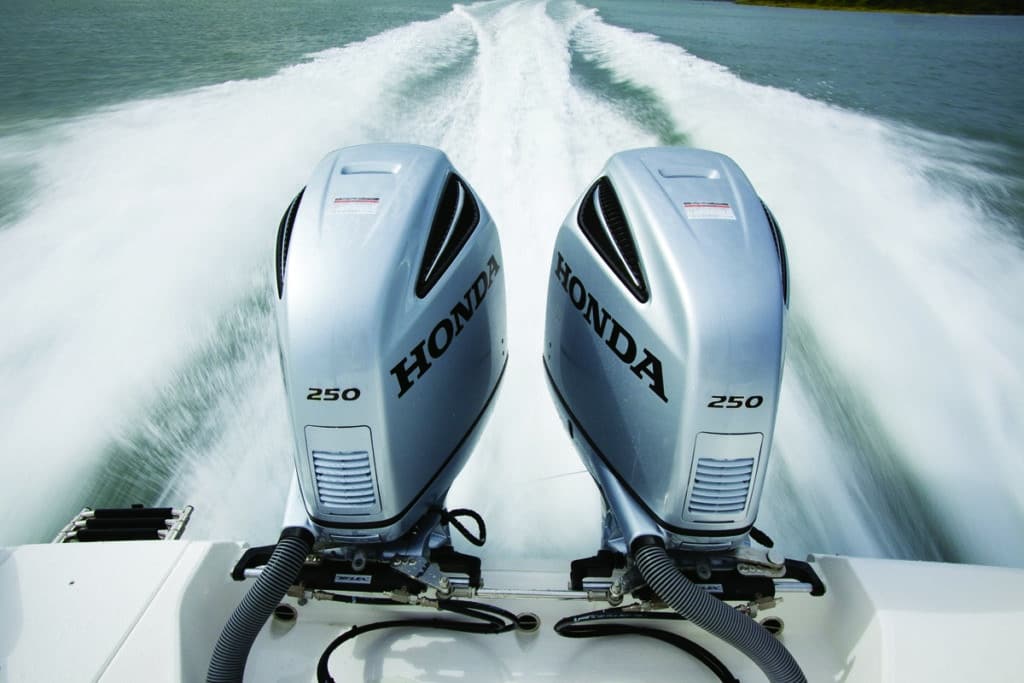
Should I change horsepower?
“Look at the boat’s capacity plate to learn the maximum rated horsepower,” says David Meeler, marine-product information manager for Yamaha Outboards . “That’s the horsepower you should put on your boat during a repower, no matter what you had before.”
Boats perform at their best with the maximum rated horsepower, Meeler points out. Plus, you’ll often get the best fuel economy because the engine is not struggling. “Just because you have the horsepower doesn’t mean you have to use it all of the time,” Meeler adds. “But it’s nice to have it handy when needed, such as when powering over a big wave.”
Should I change engine brands?
The biggest reason to change is unhappiness with your current brand, be it related to performance, local dealer service or warranty terms. If you’re satisfied with all three, there’s little reason to change brands. If you do plan to switch, check out the local dealer and make sure you’re comfortable with the available service, the product and the warranty.
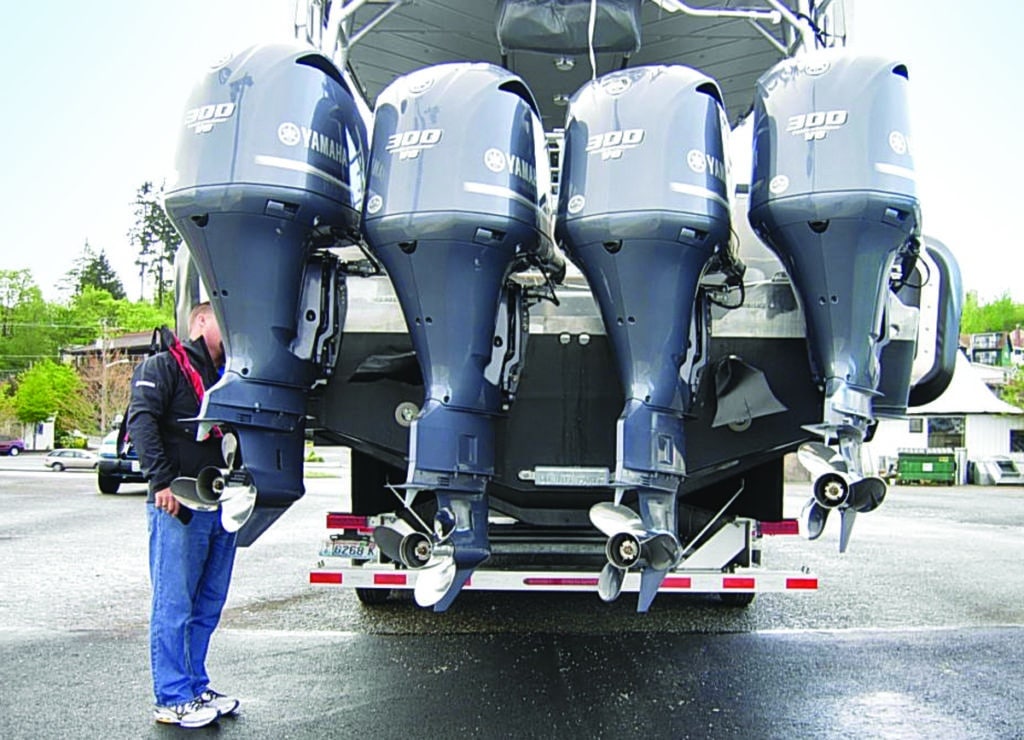
Should I change the number of outboards?
Changing the number of outboards is not a good idea, says Evinrude product manager Jason Eckman. “It’s very complex and involves lots of fiberglass work to prep the transom for such a drastic switch,” he says. “Also, adding another outboard can add too much weight to the stern, or the transom might not have enough width or structural support to accommodate another engine.”
If you want to go from a single to twins for offshore safety, that issue is hardly relevant today. “Reliability of today’s outboards is such that you should not be afraid to go 30 to 40 miles offshore with a single outboard,” says Meeler.
Should I get new controls and instruments?
It’s a good idea to update everything — steering, throttle and shift, cables, electrical harnesses, battery cables, and instruments, says Larry Teeling, product category manager for Mercury Marine . Consider the steering. “Why struggle with an old, worn steering system with your new outboard?” Teeling asks. Similarly, a new engine with old controls and gauges will only dampen your experience.
Digital instrumentation has also come a long way in the last 10 years, Teeling says, offering information that old gauges could not provide, such as fuel consumption and best speed for fuel efficiency.
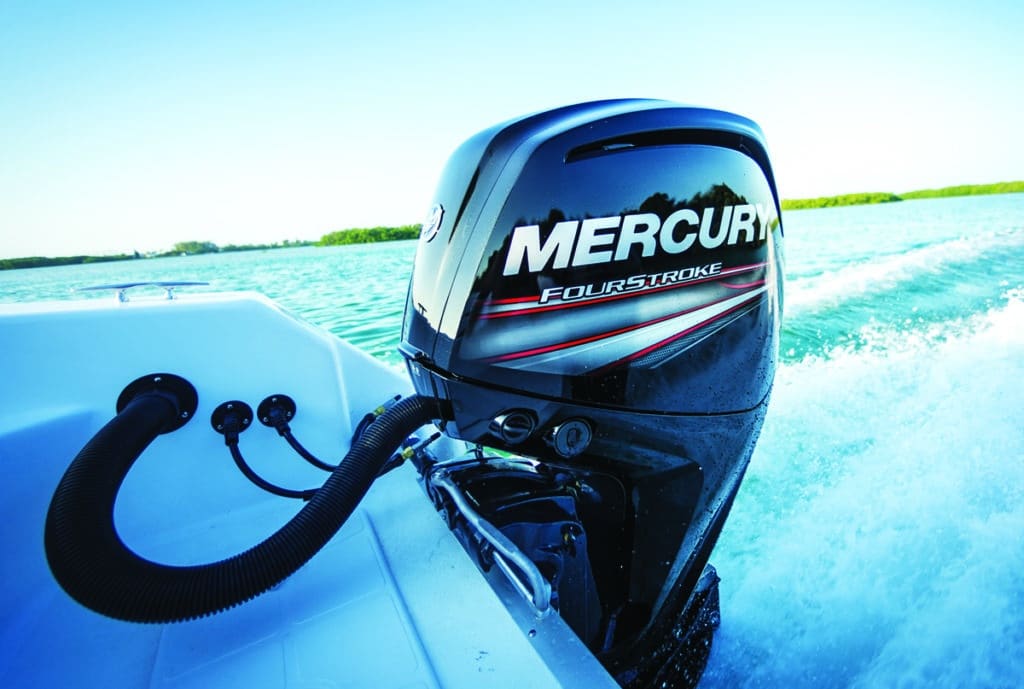
Should I change to another outboard technology?
The technology aspect of a repower has become less impactful over time, contends Teeling: “In the early 2000s, four-stroke outboards were associated with being heavier and requiring more maintenance than two-strokes. That’s no longer the case.” As two- and four-strokes approach parity in terms of weight and maintenance, the key is to select an outboard technology that makes your boat perform the way you want and maximizes its value, says Teeling.
Can I add a joystick control as part of a repower project?
Joysticks offer intuitive, slow-speed steering, allowing anyone to dock a boat like a professional captain. While original-equipment manufacturer systems with joystick controls, such as Yamaha’s Helm Master and Mercury’s Outboard Pilot , are not available for aftermarket installations, SeaStar Solutions Optimus 360 power-steering system (which includes a joystick control) can be added to an existing boat.
The decision to add it as part of a repower project boils down to three factors, says David Greenwood, product planning manager for Suzuki Marine . “First you need to have multiple outboards, as such systems won’t work with a single engine,” Greenwood points out. “Secondly, consider your experience level and the size of your boat. If you lack experience in docking a relatively large boat — say over 30 feet in length — in tight quarters, a joystick can be very helpful.”
The third factor is the price, Greenwood says. An Optimus 360 system can range from $18,000 to $22,000, plus installation costs. “Is the benefit worth the investment?” Greenwood asks. “Only the boat owner can answer that.”
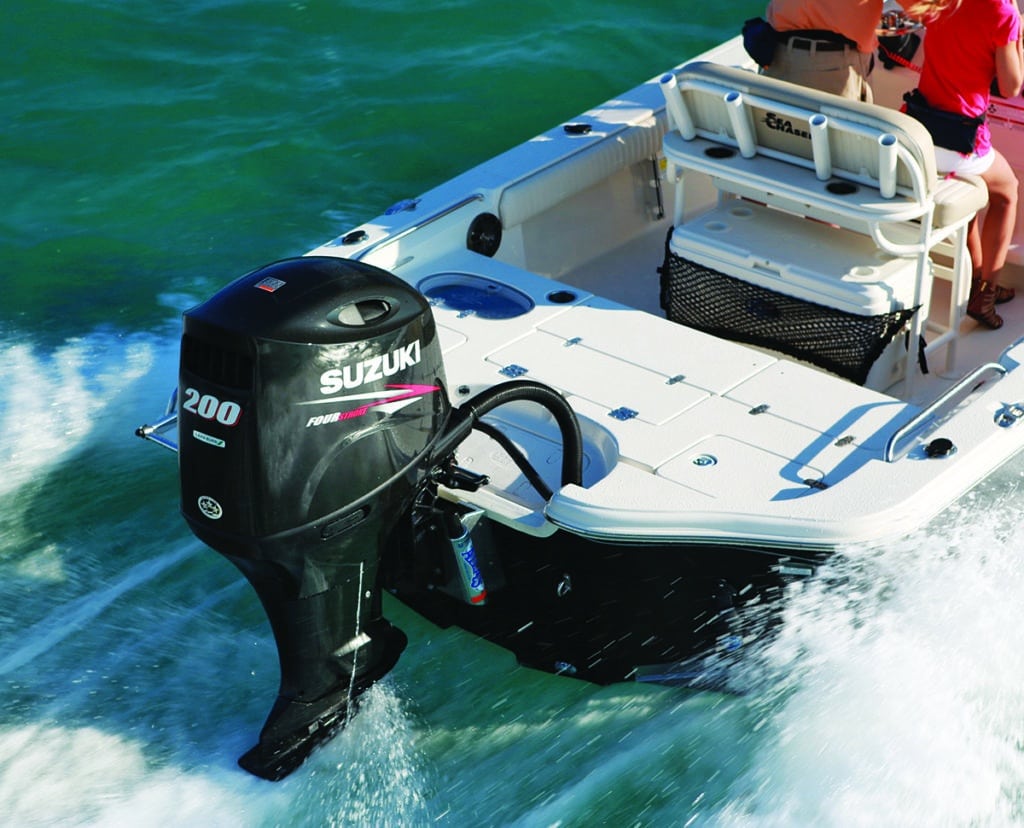
Should I install new fuel-system components?
The short answer is a resounding yes, says Yamaha’s Meeler. “I recommend that boaters replace all of the boat’s fuel hoses with new Coast Guard-approved, ethanol-resistant hoses with every repower, if not more often,” he says. “This is also the time to make sure you have a 10-micron water-separating fuel filter for each engine.”
If you’re upgrading to higher horsepower, check the engine manufacturer’s specifications to ensure that you install a fuel hose and fittings with inside diameters (e.g., ⅜ inch) sufficient to sustain the engine’s fuel needs at wide-open throttle. A fuel line or fitting that’s too small can starve the engine of fuel at the upper rpm range, not only hampering performance, but also leaning out the fuel-to-air ratio, a condition that can damage an engine.
Will my old battery system be sufficient?
The answer depends on which engine you choose. Some outboards with integrated power-steering systems and high-pressure fuel-delivery systems may require a more robust battery system. Check the engine manufacturer’s specifications or ask your dealer.
“You should also replace the old battery cables with fresh ones,” says Evinrude’s Eckman. Old cables might be corroded inside, causing too much resistance, lowering the voltage delivery, and increasing amp draw to excessive levels.
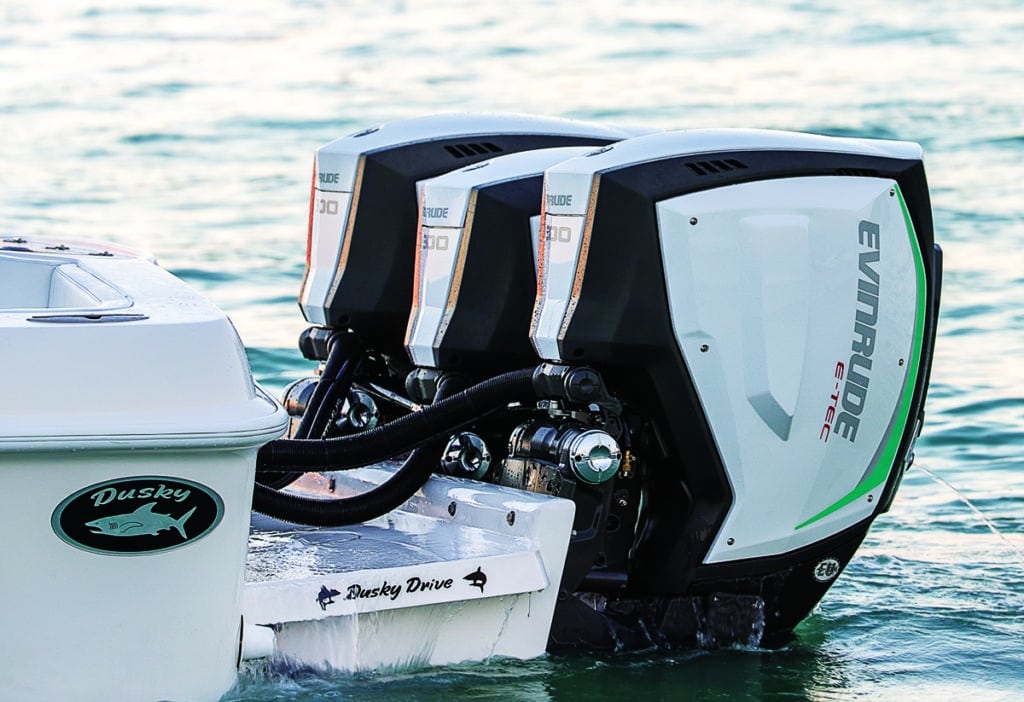
Which color should I choose?
Evinrude, Mercury and Suzuki each offer color choices in their outboard lineups. Yet color is mostly cosmetic, says Mercury’s Teeling: “Matching the color of engines to the boat has become quite popular.” In warmer climates where water spots develop quickly, white outboards are more popular, says Suzuki’s Greenwood. “White does not show water spots as much as a darker outboard will,” he observes.
What should I do with my old engine?
You can advertise your old engine for sale, but your main stumbling block will be moving a large, heavy outboard off your boat and onto the buyer’s boat. This is where a dealer can help, according to Sara Pines, public relations director for Honda Marine . “Consult with your local dealer about your old engine,” Pines says. “Often, they are willing to assist you in the selling of the old engine.”
Finally, the most important question to ask yourself is, “How long do I plan to keep my boat?” The cost of new power, related upgrades and installation charges can range from $10,000 to $80,000 or more. “For that kind of investment, plan on keeping your current boat for the next 10 years at least,” says Evinrude’s Eckman.
Yamaha’s Meeler echoes that sentiment. “The first thing I ask anyone who comes to me with repower questions is, ‘How much do you love your boat?’” he says. “The answer will help you determine what the future holds — new power or a whole new boat.”
- More: Boat Engines , fishing boats , outboard motors

What’s Good Fuel Economy for a Fishing Boat?

Yamaha Releases New 350 Horsepower Outboard
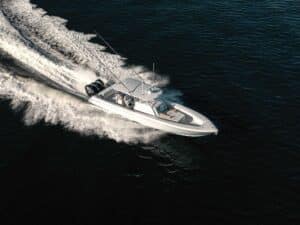
Supersize Center-Consoles Expand Angling Horizons
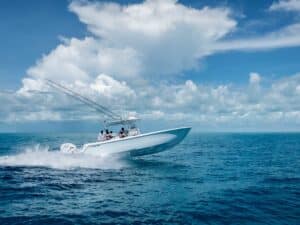
Things To Look For in a Jig-and-Pop Boat

New Gear: The Siren Connected Boat App

QUICK GUIDE: Surf Fishing Etiquette
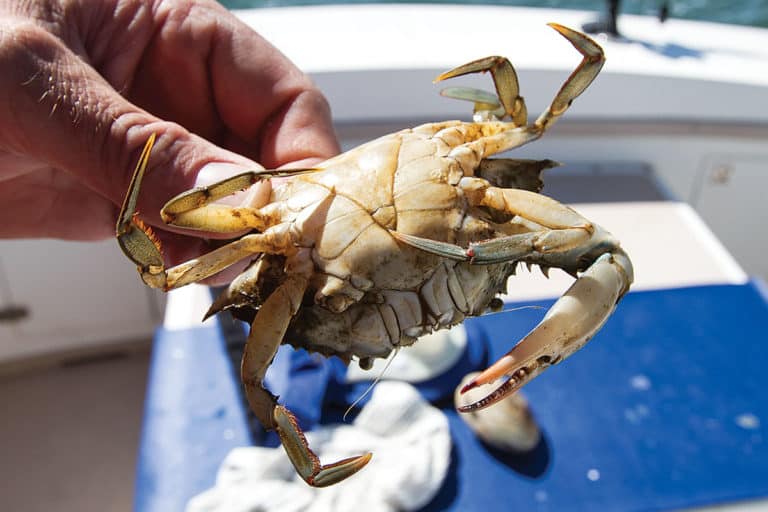
Fishing With Crabs as Bait

West Winds Are the Best Winds
- Privacy Policy
- Cruising World
- Sailing World
- Salt Water Sportsman
- Sport Fishing
- Wakeboarding
Many products featured on this site were editorially chosen. Sport Fishing may receive financial compensation for products purchased through this site.
Copyright © 2024 Sport Fishing Firecrown . All rights reserved. Reproduction in whole or in part without permission is prohibited.
- 2024 BOAT BUYERS GUIDE
- Email Newsletters
- Boat of the Year
- 2024 Freshwater Boat and Gear Buyers Guide
- 2024 Boat Buyers Guide
- 2024 Water Sports Boat Buyers Guide
- 2023 Pontoon Boat Buyers Guide
- Cruising Boats
- Pontoon Boats
- Fishing Boats
- Personal Watercraft
- Water Sports
- Boat Walkthroughs
- What To Look For
- Best Marine Electronics & Technology
- Watersports Favorites Spring 2022
- Boating Lab
- Boating Safety

How to Repower Your Sterndrive Boat
- By Charles Plueddeman
- Updated: August 16, 2021
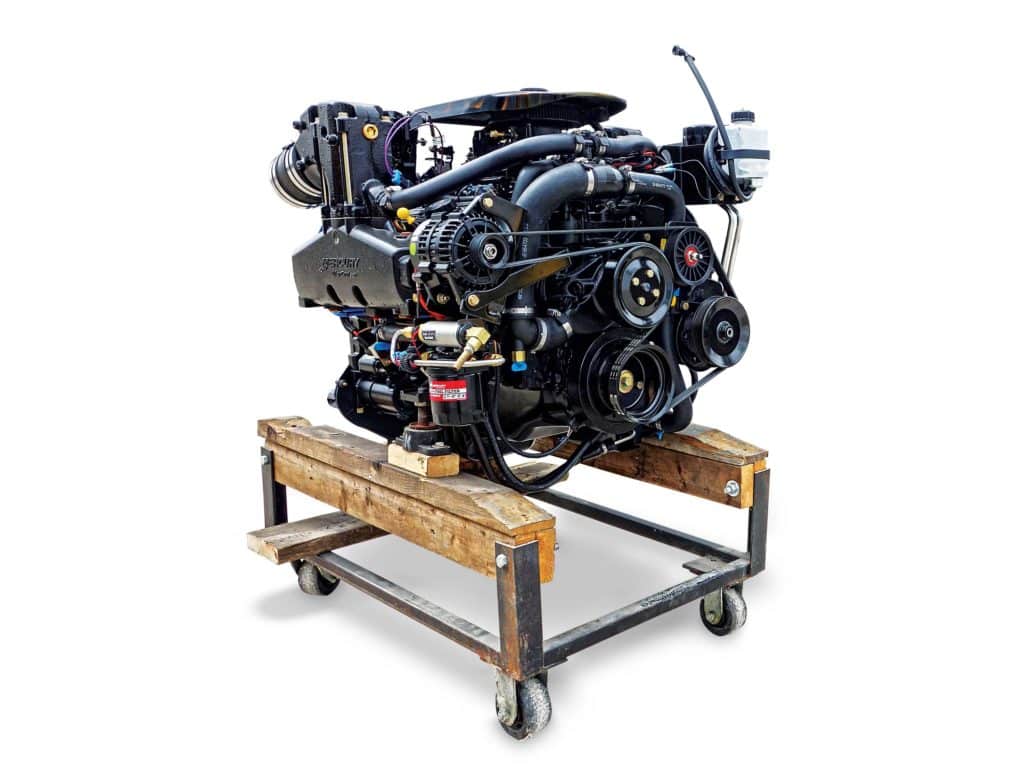
Repowering an outboard-powered boat is like playing with Lego bricks. You pop off the old outboard and snap the new one into place. But when your sterndrive engine expires, you might find yourself standing in the cockpit, staring down at an open engine hatch wondering, Now what ? What is this going to cost, and will this engine even come out of the boat? Instead of Legos, this seems more like open-heart surgery.
Fear not, sterndrive owner. The skills of a heart surgeon—or their income—are not required to get a sterndrive boat repowered and back on the water. There is no question this can be a more complex project than hanging a new outboard, but the result can provide a real upgrade in performance and reliability for a fraction of the cost of a new boat.
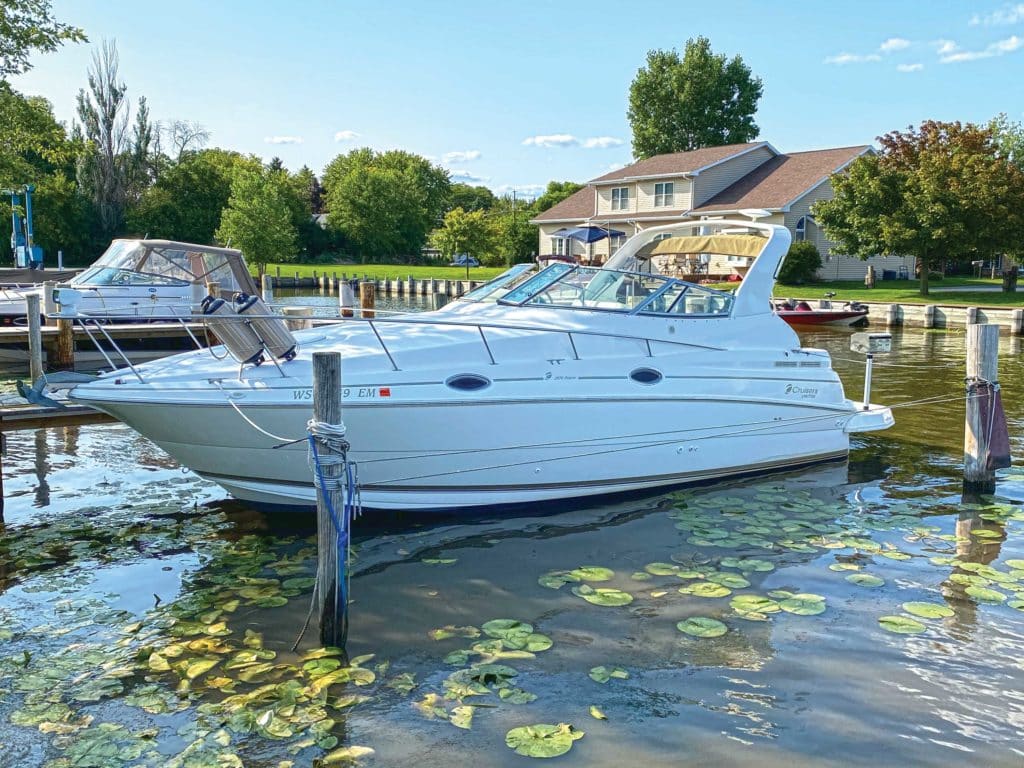
Making It New Again
For boat-owner Tim Ferguson, when the starboard sterndrive engine of his 1998 Cruisers Yachts 2870 Rogue expired after about 460 hours of operation, the cost of repowering was concerning, but not top of mind.
“This is the first and only boat we’ve owned,” says Ferguson, a senior IT manager from Dale, Wisconsin, who purchased the Cruisers in 2007. “It has huge sentimental value to the family. Our kids essentially grew up on this boat. My wife and I are now empty nesters, and it’s perfect for just the two of us.”
That sentimental attachment is probably the No. 1 reason most people choose to take on a repower project, and in this case, those emotions were backed by sound financial reasoning. The Cruisers 2870 was a well-made boat when it was new, and the brand has a good pedigree.
“Other than the engines, the boat was in really good condition,” Ferguson says. “It had a sound transom and stringers, and everything else worked well and looked good. We briefly considered purchasing a new boat, but the cost to replace the Cruisers convinced me to take a hard look at repower.”
Because he bought the boat used, Ferguson has less than the full suggested retail invested in this Cruisers Yachts from the start, and replacement options range in price from about $135,000 for a new 28-foot Four Winns Vista 275 to $338,000 for a 31-foot Formula 310 Sun Sport. I found a few used Cruisers 2870 boats for sale online, ranging in price from about $36,000 to $40,000, with plenty of hours on the engines. So, spending $35,000 to repower this twin-engine boat with brand-new engines and drives does not seem like a bad investment.
There’s another repower bonus: upgrading the performance and technology. Most examples of the Cruisers 2870 Express went out the factory door powered by twin 220 hp MerCruiser 5.0-liter V-8 engines with Alpha One sterndrives. If you think 440 hp seems marginal for a 10,000-pound (dry) boat, we agree. Taking on the repower project gave Ferguson the opportunity to upgrade to a pair of 5.7-liter 300 hp MerCruiser 350 MPI V-8 engines, which feature multipoint fuel injection for much-improved starting, fuel economy and smoother operation than the original-equipment carburetors. Fuel injection is also more resistant to ethanol-related issues that plague carbureted engines.
Ferguson had the work done at Lakeside Marina in Oshkosh, Wisconsin, working with service consultant Tom Smock and technician Dan Jansen to devise the repower plan. Ferguson considered engine options from Mercury Marine, Quicksilver and a Wisconsin shop selling remanufactured long-block marine engines. They settled on Plus Series remanufactured complete engines from Mercury Marine, new MerCruiser Alpha One drives from Mercury, and new Quicksilver transom assemblies (which include the gimbal housing, rear engine mount, trim rams and more). Upgrading to MerCruiser Bravo drives would have doubled the cost of those components—too big a blow to this project’s budget. Note that Mercury Marine offers up to $50,000 in repower financing. There are aftermarket options as well. Sterndrive Engineering Inc. sells a complete drive to replace an Alpha for $1,655 and the transom assembly for $1,725, with a three-year warranty.
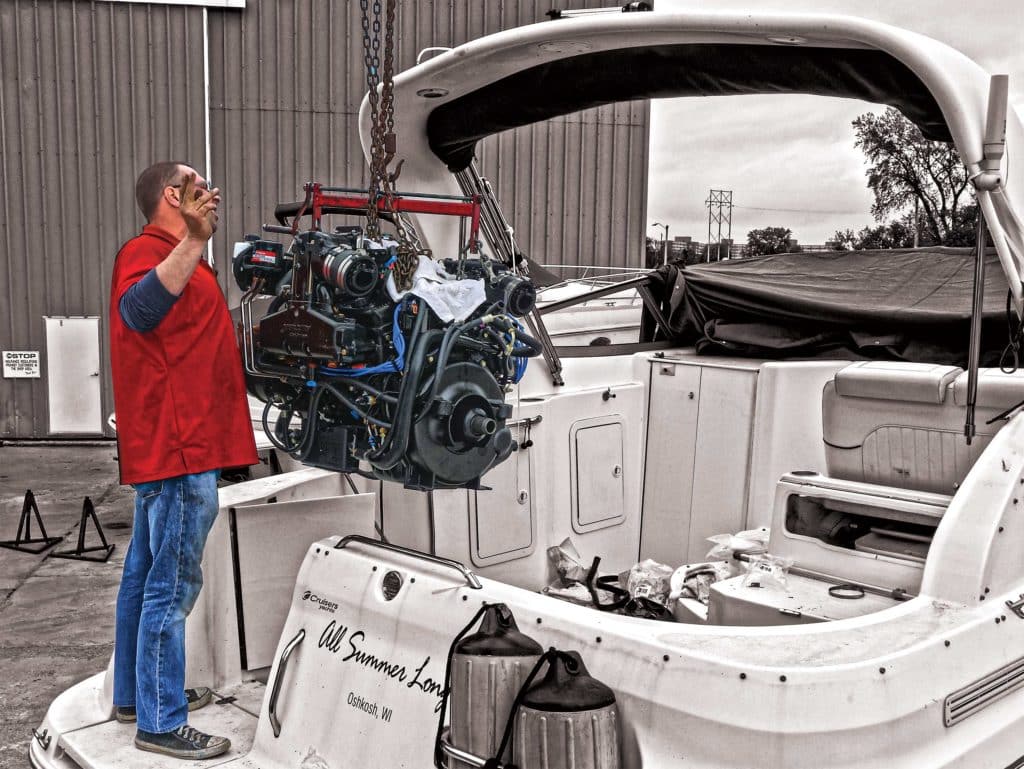
Jansen has 18 years of experience as a marine tech and has done a number of sterndrive-repower jobs. As with an outboard repower, boat integrity is key, so his first step is always an inspection of the transom, stringers and engine mounts, all of which can be repaired but at significant cost. A concern that never comes up with an outboard repower is the task of removing the engines from the boat. Most builders—but not all—take this into account when designing the engine hatches and surrounding deck. Jansen recalls one sterndrive-repower project that required cutting away a portion of the deck to remove the engines. Jansen was able to get the engines in and out of the Cruisers 2870, but it was an operation that required some precision. I was on hand when the starboard engine was installed using a chain hoist and a large fork lift. Jansen had to lower the engine through the hatch sideways and then turn it 90 degrees once it was below the deck level. There was less than an inch to spare, and the operation was further complicated by the position of the sport arch over the engine-hatch area.
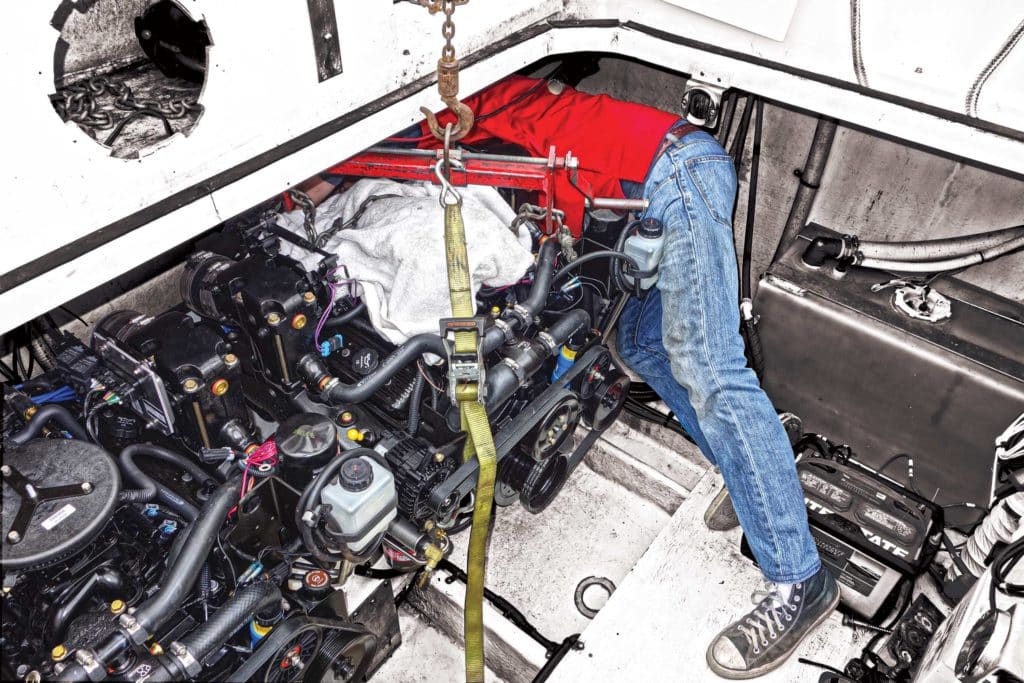
Installing the first engine was not much trouble, but the second engine was a much more physically demanding challenge because there is just a few inches between the two engines, which had Jansen wiggling around in the bilge to reach engine-mount bolts. In fact, he owns a special “stubby” Snap-On wrench he uses only for reaching and tightening these mount bolts. A single-engine installation is obviously often a little easier.
Ferguson says he’s still working on propping, but already the performance gain is significant.
“The engines start instantly; hard starting was becoming more and more of a problem with the old engines,” he says. “When we got the boat, it would top out at about 41 mph but, after 14 years, top speed was down to 37 mph, and the boat struggled to plane with a heavy load of guests. Now it pops right on plane, and we are already seeing 45 mph using the old props. It will only get better.”
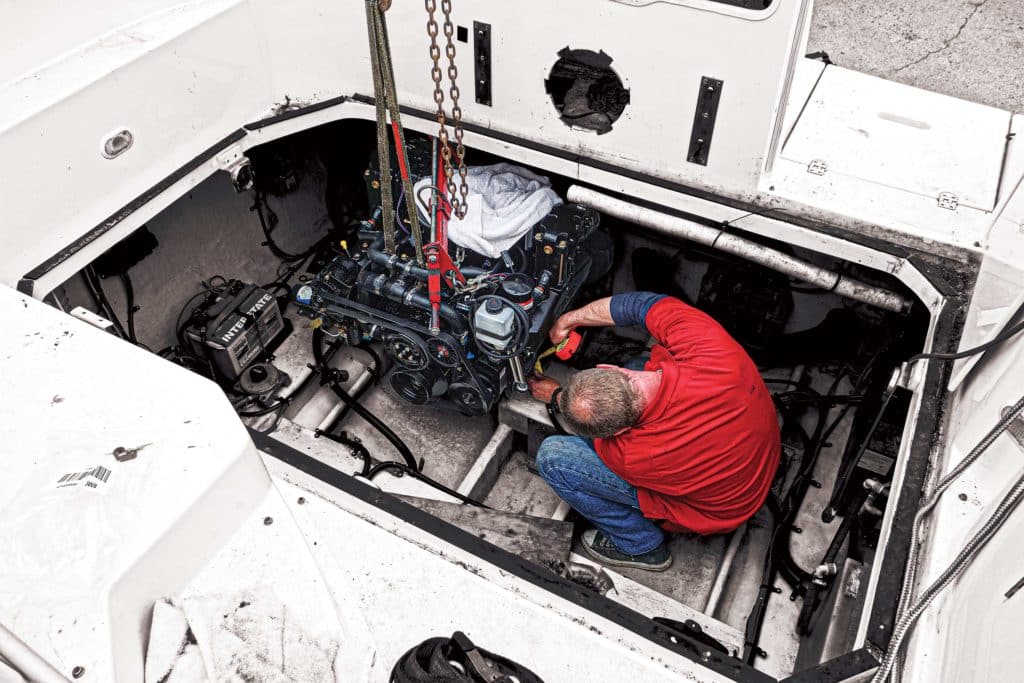
While the boat was in the shop, Ferguson had an extended swim platform and new cockpit carpet installed, added a Garmin multifunction display to the helm, and installed a Mercury VesselView Link engine display, which he wirelessly connects to an iPad to monitor engine vitals. This past summer, Lakeside installed cabin air conditioning. The result? This boat is better than new.
Thinking of taking on a repower project? Here are some questions you might want answered.
Can I Switch Brands?
Fancy replacing your MerCruiser with a Volvo Penta, or vice versa? It can be done. Volvo SX drives made since 1994 and Volvo Duoprop drives made since 1996 use the same transom cutout as MerCruiser drives, although some techs we spoke to say that going from Volvo Penta to MerCruiser can still result in a leaky transom. Volvo has no program to sell new or remanufactured legacy engines, so you’d need to buy a current model with ETC to get a brand-new Volvo engine (figure about $30,000 for a 5.3-liter Volvo V-8-300-C with an SX drive). Quicksilver offers long blocks and some complete engines that will mate to a Volvo drive. Swapping brands also might require new controls, instruments and a wiring harness. Another option could be Ilmor, which, through its dealers, offers small-block and big-block catalyzed engines from 365 to 483 hp. An Ilmor engine can be mated to its One Drive or to a MerCruiser Bravo drive. The One Drive cutout is slightly different from what’s required for a MerCruiser, but it is workable, according to Ilmor.
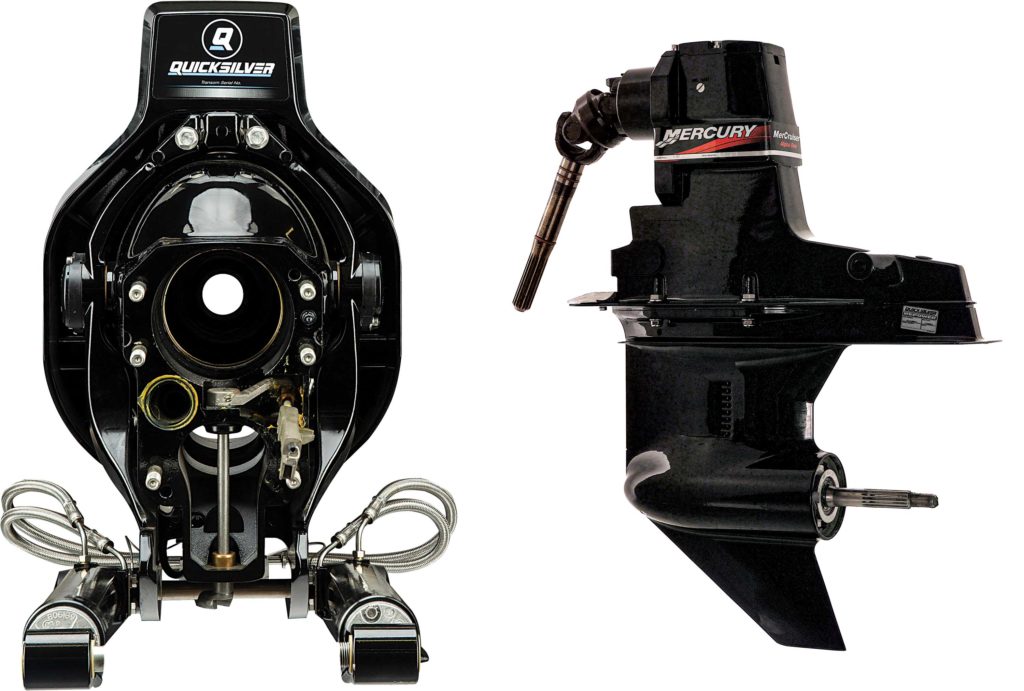
What Are My Engine Options?
Complete Engine: This is a complete, all-new engine top to bottom, ready to drop into your boat, either a current MerCruiser or Volvo Penta engine, or a legacy pre-emissions control technology engine. The Quicksilver division of Mercury Marine might be the biggest manufacturer of new marine engines intended specifically for repower in pre-ECT boats, from 3.0- to 8.1-liter displacement. All except 3.0-liter models are fuel-injected and come with a three-year warranty.
Remanufactured Engine: A “reman” is a used engine that is disassembled and then rebuilt. Parts that are in good condition are reused; those that are not are replaced with either good used parts or new parts. Dress components—exhaust manifolds, alternator, ignition, fuel system and more—are replaced with new parts. These engines typically have a one-year warranty and cost several thousand dollars less than an all-new engine.
Crate Engine: If the engine to be repaired has internal damage but the dress components are in good condition, a crate engine might be an option to consider. A crate engine is a major assembly—either all-new or reman—that includes a new long block as well as the fuel-delivery and ignition components. The engine is completed by reusing many dress components from the engine being repaired, or those components must be purchased separately. These might include engine mounts, the fuel-handling system, exhaust system, starter, alternator, seawater pump and power steering. Installing these components adds to the labor cost of a repower project, but it also makes the engine adaptable to either MerCruiser or Volvo Penta installations.
Read Next: Seven Engine Repowering Tips
Long Block: A long block is an engine—new or reman—without dress components (alternator, water pump, etc.), or the exhaust or fuel system. A long block might be an option to consider if the original engine has a cracked block but low hours, if the exhaust is free of corrosion, and if the fuel system is in good shape because you’ll want to reuse those parts. Removing and reinstalling all those components adds to the labor expense, but an all-new Quicksilver 5.7-liter long block is only $6,269.
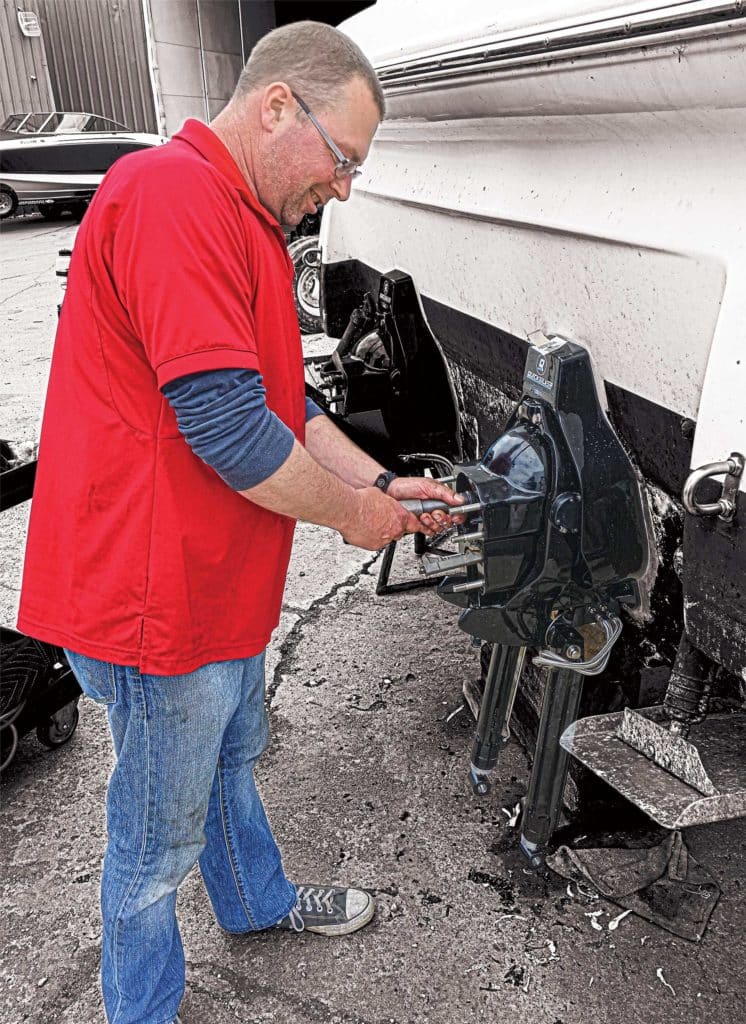
Essential Alignment
Engine alignment with the transom is absolutely key, according to Jansen, who says he has spent hours getting that alignment just right—using a special Mercury tool that slides through the transom to the end of the engine-output shaft, and climbing in and out of the boat when nobody’s around to help—to bump the engine a fraction of an inch this way or that on the mounts.
“I know that if I don’t get the alignment right, I’ll have to pull these motors again in 40 hours to replace the rubber drive-shaft coupler,” Jansen says. “Mercury says you should be able to slide the alignment tool in and out using just your fingertips. It takes some patience.”
Cost Breakdown
- Two MerCruiser 350 MPI 300 hp reman engines: $22,638.32
- Labor to install and test engines: $2,391
- Two new Mercury Alpha One drives: $6,671
- Two new Quicksilver transom assemblies: $4,736
- Two MerCathode units: $346.50
- Labor to install transom assemblies and drives: $1,155
- Miscellaneous parts required to complete the installation (gear lube, filters, hoses, etc.): $500
- Total: $34,438
Know the Law
Emission control technology, in the form of exhaust catalysts, has been required on sterndrive engines in new boats sold in California since 2008, and since 2010 in the other 49 states. If you use a new engine to repower a boat built since either of those dates, you must use an engine equipped with ECT. You may repower an older boat with a new non-ECT engine, but the engine you remove from the boat must be returned to the engine builder, which will scrap the engine and certify to the federal Environmental Protection Agency that the engine is out of circulation. If you repower with a remanufactured engine, no return is required. Thinking about installing a current MerCruiser or Volvo Penta engine in your older boat, maybe to get digital controls and lower emissions? Measure carefully. Most current-model engines are physically larger than pre-ECT engines and might not fit in the engine bay.
- More: Boats , Engines , repower , stern drives
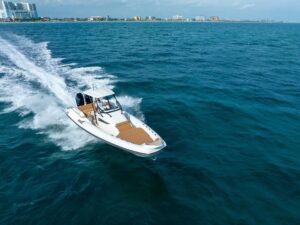
Boat Test: 2024 Nuova Jolly Prince 33 CC
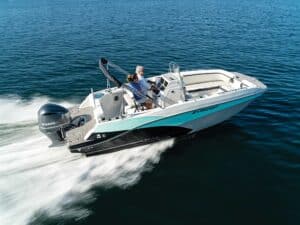
Boat Test: 2024 Starcraft SVX 231 OB CC
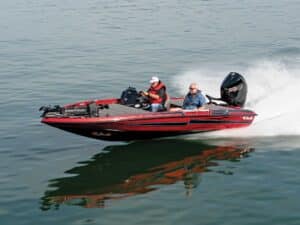
Boat Test: 2024 Bass Cat Caracal STS
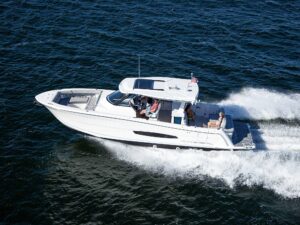
Boat Test: 2024 Regal 38 Surf

I Learned About Boating From This: Capsize, Rescue and Lessons Learned
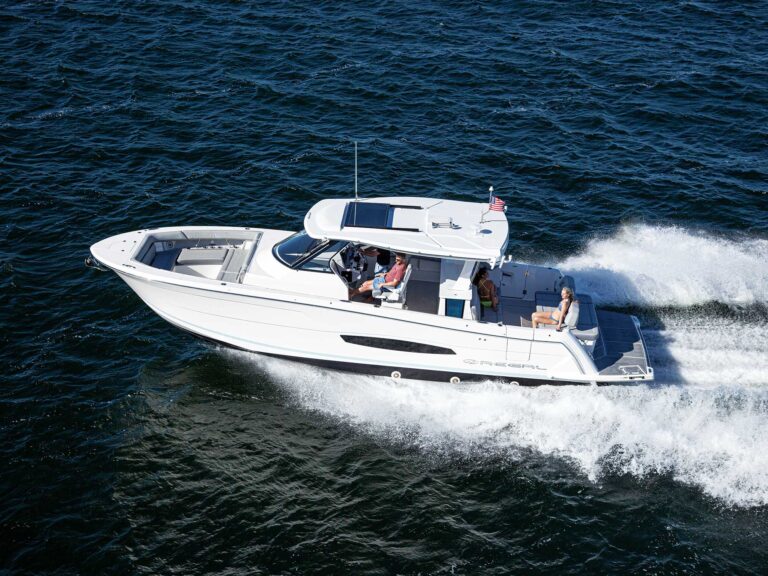
Using Hydrofoils to Improve Boat Performance
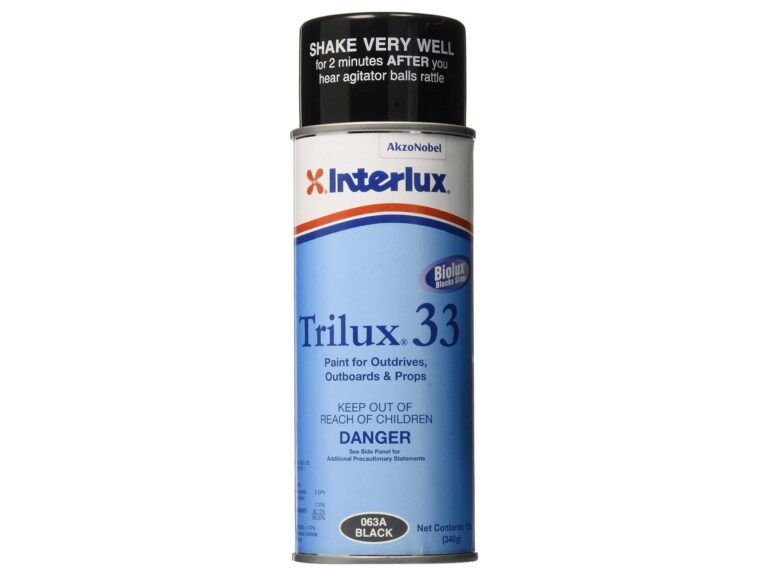
We Test Interlux Trilux 33 Aerosol Antifouling Paint

- Digital Edition
- Customer Service
- Privacy Policy
- Cruising World
- Sailing World
- Salt Water Sportsman
- Sport Fishing
- Wakeboarding
Many products featured on this site were editorially chosen. Boating may receive financial compensation for products purchased through this site.
Copyright © 2024 Boating Firecrown . All rights reserved. Reproduction in whole or in part without permission is prohibited.

How Much Does It Cost To Repower A Boat?
Repowering a boat will save you money and extend the lifespan of your fishing vessel. Simply rebuilding the engine or purchasing a different engine are great ways to avoid investing in a new boat.
Boats last for decades, even the ones built today. You can extend the lifespan of your boat by repowering it. It can save you money, time, hassle, and the chore of reselling your boat which has an engine issue.
The boat itself can have its life prolonged for years without anything too major, at least if you buy new or close to new. A boat's engine is good for a good many years too but eventually, it's going to need some costly repairs. An overhaul. Even a replacement, in some cases.
When you do finally have an extreme engine issue that is either costing you money in continuous maintenance or has quit altogether, sit and think about it for a while and see if repowering your boat makes more sense. It almost always does!
You know it's probably the right thing to do. But how much does it cost to repower a boat? Is it worth it? This detailed boat repowering guide will help you make the right choices on this difficult issue.
Is It Worth Repowering a Boat?
Many boat owners like yourself are starting to consider repowering their boats because of the recent boom in outboard motor availability and options. There has never been a better selection of new and used boat motors in the marketplace, so this is a great time to think about swapping your old engine out for a new one.
Repowering your outboard-powered boat is a much better option if you can’t afford to buy a new one, don't want to buy a new one, or if you love the boat you have and just want to add some more power to it to give you more security and adventurous options.
A brand-new motor with more power can be worth it in a number of ways. If your current motor can't get you on plane, and a new one could, you'll save gas. Fuel efficiency is a great reason to exchange your old motor for a stronger and more fuel-efficient one.
Or maybe your old motor is just not reliable anymore and you can't take those longer trips that you used to because you don't want to be stuck somewhere needing a major engine overhaul, or worse, be towed back to a port before needing a major overhaul!
If you're really considering more power for your boat, you might consider more than one engine to replace the faulty one you have. Now you're talking real power and money, but you're also going to open up options you never had before with your present boat.
There are lots of things to consider. It could be a simple swap out, or it could be a more complicated project involving adding more engines and horsepower than you ever had before.
You have to decide yourself whether your situation warrants another used engine, a new one, or multiple engines. You may decide that it is worth it and go for it. You'll probably be a lot happier after you finally make the decision.
Here is a quick look at each of the repowering options you have available.
1. Going Digital
New engines mean new features such as screens for monitoring engine performance, digital controls, and plugins with a single electrical connection. Evinrude E-TEC G2 outboards are now available with hydraulic power steering, all digital controls, and i-Trim automatic trim.
Evinrude offers the E-TEC G2 150 with conventional steering for those who want to do repowering projects. Their Evinrude E-TEC G2 emissions are rated better than any engine in its class and provide another benefit, up to 15% better gas mileage as well.
Evinrude offers rigging harnesses that convert older systems to digital ones. The Universal Repower Rigging System mounts on your boat to change the push and pull mechanical cable movement of your motor's accelerator to a digital throttle. Use them for low-cost repowering.
If you haven't looked at boat motors recently, take a trip over to your favorite Evinrude or Mercury motor dealer and ask them to give you an overview of all that has happened in the last few years. You'll walk out of there with a new understanding of what you can do to upgrade your boat with a new engine that will put a smile on your face.
2. The Boat’s Current Condition

When considering whether or not to repower your boat, one of the first things you need to do is to objectively assess whether the vessel is still in good enough shape to handle a new engine.
You may decide that spending a few hundred dollars to hire a good surveyor to inspect your boat from top to bottom is a good idea before spending a lot of cash on a new motor. Boats can stay together for a long time and look great from the outside, even with serious issues. It's a good idea to survey if you have any doubts about the condition of your boat.
Remember, hull-to-deck joint separation can occur during a hard bump, or even just over time as your boat ages. The stringers are like the spine of the boat and if they separate from the hull or worse, break, you're in for some real problems.
RELATED: Carolina Skiff Review
3. Top Speed
If the top speed of the boat is a consideration when you repower, you can get close to what you once had with your original motor if you just buy a motor with the same horsepower. That's not the end of the story though. The gearing ratio matters and can mean the difference between having powerful torque from a dead stop, and the extent of your top-end speed at maximum throttle.
If you are considering increasing the top speed of your boat, a survey can find out whether or not your boat can handle going any faster. You may know the manufacturer's specs and what their stated top speed is, but your old boat may not be able to do that anymore. Get the survey, and a clean bill of health before you upgrade motors that will take you faster on the water.
Going faster is not usually a matter of just changing your prop or some gears in your old motor. The motor was built for a certain performance range. When you extend that and go beyond what it was intended for, you can run into serious motor damage – even blown engines.
Survey first, then go visit a boat motor specialist who can advise you on what you can do to go faster and still remain safe.
RELATED: Small Boat Stabilizers For Safe Fishing
4. Power Surge
Many owners want to go a little crazy on the horsepower and really take it to the next level when they repower a boat.
The manufacturer of your boat will know the maximum speed the boat was intended to go. It will also know the maximum rated horsepower the boat can handle safely. Don't go beyond these specifications or it can end in tragedy. The United States Coast Guard also has recommendations posted for boats with particular measurements, and weight, and it's best not to go beyond that.
5. Weighty Questions

After making the sometimes gut-wrenching decision about whether to repower your boat or replace it, let's say you're going to repower it.
There are so many things you must know before you choose the new engine unless you are going to get a new one just like the one you had previously.
For instance, four-stroke outboard engines are considerably heavier than two-stroke versions. Some boat manufacturers advise against replacing two-stroke outboard engines with heavier four-stroke engines because in many cases, the transoms were not built to handle them. You'll need to know how much weight your transom can hold in addition to knowing the maximum power you can apply to the boat without it falling apart.
Your manufacturer can help you with nearly any question about repowering your boat. They've already handled the same questions from other buyers and they are probably eager to share the information with you because it might mean they get the opportunity to sell you something else.
Today, most outboard engines can be similar in weight and size to each other but how they're built may differ and require you to know more about the differences. The Evinrude G2 engines mentioned above feature internal steering gear and oil tanks. Your old engine almost certainly doesn't. This means the weight is redistributed and you have to know the implications of this if you decide to install one or more of these motors on your fishing boat.
RELATED: How To Determine Trolling Weight To Depth Ratio
6. Two-Stroke or Four-Stroke?
In the 1980s, 4-stroke engines were first introduced and offered the carrot of better fuel economy but came with the dreaded 'less low-end torque' curse. Thankfully, technology has changed since then!
Today, 2-stroke outboard engines still provide lots of power in the low and mid-range, something that tournament anglers and a lot of bass anglers care about. You might think you need a 2-stroke to power your Jon boat , skiff, or bay boat to realize that addictive torque you love so much. but 4-strokes are changing the game.
Evinrude G2 outboards (2-stroke) are more fuel efficient because they are built around fuel injectors that inject the fuel directly into cylinders. The 4-stroke engines, on the other hand, are getting lighter and are making gains in mid-range torque through various means.
For instance, Mercury's Verado 350-hp motor uses a supercharger to give it more low-end torque than even 2-stroke engines. So, it has the power, fuel efficiency, the reliability, and is a huge step up from old carburetor-powered motors. Most outboard engines are now fuel injected and have done away with inefficient carburetors.
RELATED: Top Skiff Boat Manufacturers
7. One Engine or Two?
Sometimes going with one bigger outboard motor rather than two smaller ones or having a pair of motors instead of three is the smartest choice. Saving weight can be a dramatic factor to consider when swapping out engines, especially if you're considering multiple engines to replace a smaller number of them.
Boat makers recommend that with two motors on a boat of the same horsepower, one of them should be strong enough to plane the boat with a couple of passengers, or whatever is the normal amount of people you carry.
If the weight and horsepower are the same, a twin-engine setup will have a lower top speed, and a lower cruising speed, and consume more gas than one motor would.
How Much Does It Cost to Put a New Motor On a Boat?

A typical gasoline boat engine can go for about 1,500 hours before it will need some significant repair to keep going strong. Diesel engines are much hardier and can go about three times that before needing an overhaul.
Engines that are well taken care of can go for many years, but most people don't prioritize taking care of their motors, thinking they will run indefinitely. Owning a boat is a real test of responsibility and not that many people are up for the challenge, and so they pay for it later in repairs!
How much it costs to repower a boat will depend on too many factors to give you a dollar amount you can count on. You should definitely shop around. There isn't much difference between Evinrude, Mercury, and Yamaha engines, especially when comparing their smaller engines.
The cost of new engines ranges from around $8,300 for a Mercury 50 hp outboard motor all the way up to $35,000 for a 300 hp V-8 Mercury.
Removing your old engine and installing the new one will add more costs which increase with the weight. If installing the new engine is a tricky fit, that also can increase costs. Where you are in the world can also dramatically affect engine installation costs.
RELATED: Cheap Poling Platform DIY Ideas
How Long Do Boat Engines Last?
The boat engine is one of the most important features of any boat, even a catamaran or sailing yacht, as you will rely on it for crucial movements in the water around a dock or when the wind is low.
If you run your boat engine for four hours a day doing commercial charters you're going to need to overhaul the engine in just about a year's time and put some more money into it to keep it running.
An engine running close to max output over that year is going to need more maintenance than one that runs at only 50% power. So, it's possible that your boat motor lasts for two years if you're not abusing it by running it into the redline often.
The average outboard motor use is around 200 hours per year. Your engine can last 7-8 years at that easy load. If you replace the oil after every 50-100 hours of operation and regularly flush the engine, you can see even better engine life.
Gasoline engines don't last as long as diesel engines which can go for 5,000 hours before needing a major cleaning, lube, seals, replacing rubber tubes, and other essential maintenance.
A typical Mercury outboard engine can last 3,000-4,000 hours with proper care and regular maintenance.
Motors are made for long, continuous rides. They perform better with this type of operation. Just like a car or motorcycle does. If you only take your boat out for short trips and constantly start and restart the engine every time you use it, your engine will probably fail sooner than if it was used on longer trips without all the starting and stopping.
Engines can fail in any of a number of spectacular ways, but one way you can see it coming is to always pay attention to the color of the smoke. A change in the color is certainly due to something, so figure it out quickly!
RELATED: Best Prowler Trolling Motor And How To Use It
Repowering your old boat is an affordable option when compared to buying a new boat or continuously pouring money into repairing the engine for it to function. Typically, good engines last for 3-4,000 hours if well taken care of, so the new engine you buy for your boat can probably last more than 10 years if you use your boat about as much as most people do.
Your decision about whether to repower your boat engine requires that you take into account many factors like the cost for the engine, the cost for the installation and removal of your other engine, horsepower needs and maximums to adhere to for safety, fuel efficiency, and just how good you'll look in a boat with a new engine.
Take a good hard look at what you'll be using your boat for over the next couple of years and see if it makes sense for you to repower the boat you have instead of selling it and buying a new boat at extreme cost. It may be worth it to buy a new boat if your current boat has seen the end of its life. Boats last 40-50 years though and your best bet economically is to repower your boat and keep it longer.
What will you do? Let us know if our guide helped you come to any conclusions or inspired creative thinking about whether or not you need a new boat or just to repower what you have. We'd love to hear from you!
RELATED: Technical Poling Skiffs For Fishing Shallow Waters
Brian Hopkins
Leave a Comment Cancel reply
Save my name, email, and website in this browser for the next time I comment.

IMAGES
VIDEO
COMMENTS
The average costs of repowering a 28- to 34-foot sailboat ranges from around $7,000 to $12,000. This doesn't allow for V-drive transmissions, which always add to the labor cost because of the extra time involved. Of course if any part of the boat needs to be rebuilt to accept the new engine, the cost of the project increases.
Generally, repowering a boat improves the power-to-weight ratio (making your boat easier to handle), maximizes speed and power, and offers a more enjoyable boating experience overall. 2. Extend the Boat's Lifespan. A properly-maintained boat engine lasts many years - extending your time on the water.
The question facing you now is: Should you rebuild the existing engine? Or repower with a brand-new engine? Let's start with the cost of repowering. "You're talking probably between $12K and $16K for a 30-footer, and $18K to $22K for a 40- to 45-footer," says Mike Muessel of Oldport Marine, in Newport, Rhode Island, who's repowered ...
The whole idea is to find the ideal balance. Simply replacing your 25- or 30-horsepower auxiliary engine with a 75-horsepower turbocharged model might sound good, but there's more to consider than pure muscle. First off, the 75-horsepower engine might simply be too heavy for your boat.
Repower your boat because you plan to keep it and reap the benefits of the new engine yourself. The value of your boat will certainly increase with a new engine, but rarely enough to recoup the costs immediately if you are only repowering with the intent to sell. The same is generally true if you convert from gas to diesel.
COST VS. VALUE Repower your boat because you plan to keep it and reap the benefits of the new engine yourself. The value of your boat will certainly increase with a new engine, but rarely enough to recoup the costs immediately if you are only repowering with the intent to sell. The same is generally true if you convert from gas to diesel.
Let's look at two of the important emission aspects while repowering your boat: 1. Compliance with emission regulations: Most often when your vessel is under EPA regulations, you can repower your boat using an engine that has an equivalent or better emission level with the engine being replaced. Meanwhile, emission compliance often has local ...
Discounts on fuel, transient slips, repairs and more at over 1,200 businesses. Deals on cruises, charters, car rentals, hotel stays and more…. All for only $25/year! Join Today. There are many considerations when starting a repower project, including some that are unrelated to the performance requirements of your boat.
Repowering your boat is a major decision and there are several things to consider. We've collected some important information to help guide you through this decision and process. Connect with a certified YANMAR dealer or distributor when you are ready to make the next steps in your repower project. Download the Guide. E-News.
Boats between 10,000 and 14,000 pounds need the 20 hp Beta Marine engine. Boats between 14,000 and 18,000 pounds require the 28 hp Beta Marine engine. The above Sailboat engine repower diesel engines are available with Atomic 4 engine mount spacing at no additional cost. This precludes the need to modify the engine bed or stringers to ...
When you plan to repower a 32 to 34-foot sailboat, you can consider a cost of around $6000 to $7000. Repowering an engine might appeal to people, but there is another option, you can install a new machine. That will mean removing the old one, and here the price can move around from $2000 to $4000. On average, you can look forward to spending ...
When you have an older boat like we do — a 1987 Moody 422 sloop — and you're living aboard and cruising it full time, the process of repairing and replacing gear is part of life. ... Besides the cost of the actual new engine, there are many more costs associated with a repower. New fuel lines, hoses, wiring, shaft, an exhaust system and ...
The complete package propelling Rock Proof's ePro 1760R, a boat we tested in Boating 's March 2023 issue, utilizes Elco's EP-50 and 20 kWh of lithium batteries; it sells for about $22,500. The Torqeedo Deep Blue 110i is equivalent to a 135 hp internal combustion engine. Courtesy Torqeedo.
Choosing the correct engine to repower your sailboat depends upon several different criteria. Utilize the Beta Marine experts that are ready to help. (252) 249-2473. Toll Free: (877) 227-2473 . [email protected]. Parts Store; Engines. Small Engines (14 - 38 HP) Beta 14; Beta 14 Atomic 4 Replacement;
A repower might require more than a new engine, depending on the boat's age, and that's where the repower center can guide the customer. Boats that are candidates to get repowered are typically between five and 20 years old. "It could be as simple as unbolting their current engines and putting new engines on or it could be a complete tear ...
Lack of engine access on some boats can add significant cost to a repower project. I have estimated and overseen dozens of repower jobs—mostly on inboard powerboats over 30 feet, but also on I/O's, sailboats, and outboard boats. Replacing any boat's engine(s) is a project that should make financial sense.
To get a general idea of how much power you need for your boat repower, you can use your boat's weight as a guide. Convert your boat's weigh into pounds, so a 2.2-ton boat becomes a 5000 pound. Normally, for a fairly average performing boat, you need about one horsepower (hp) minimum for every 25-40 pounds of weight (the range is wide ...
Exceeding that limit can be dangerous and may cause you to lose your insurance coverage. If your boat doesn't have a placard, you have to do the math. A general rule of thumb is to plan for one horsepower per 20-40 pounds of boat weight. So, if your boat weighs 6,000 pounds, you'll be looking at 150-300 hp combined power.
If you lack experience in docking a relatively large boat — say over 30 feet in length — in tight quarters, a joystick can be very helpful.". The third factor is the price, Greenwood says. An Optimus 360 system can range from $18,000 to $22,000, plus installation costs.
There's another repower bonus: upgrading the performance and technology. Most examples of the Cruisers 2870 Express went out the factory door powered by twin 220 hp MerCruiser 5.0-liter V-8 engines with Alpha One sterndrives. If you think 440 hp seems marginal for a 10,000-pound (dry) boat, we agree. Taking on the repower project gave ...
The cost of new engines ranges from around $8,300 for a Mercury 50 hp outboard motor all the way up to $35,000 for a 300 hp V-8 Mercury. Removing your old engine and installing the new one will add more costs which increase with the weight. If installing the new engine is a tricky fit, that also can increase costs.
Armed with this knowledge, you should be able to make a smart choice when repowering with an outboard in 2021. For the manufacturer's information on all the brands mentioned above and on all current outboard offerings, visit: Honda Marine. Mercury Marine. Suzuki Marine.
With a new Mercury outboard, you can enhance your boat's capabilities with the backing of a full Mercury Limited Warranty. We even offer Mercury Repower Financing so you can finance the entire repower package - including rigging, gauges and installation - with low rates and low monthly payments.